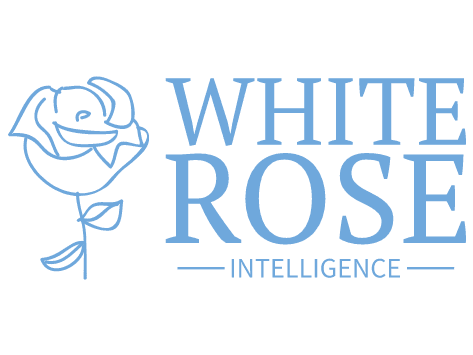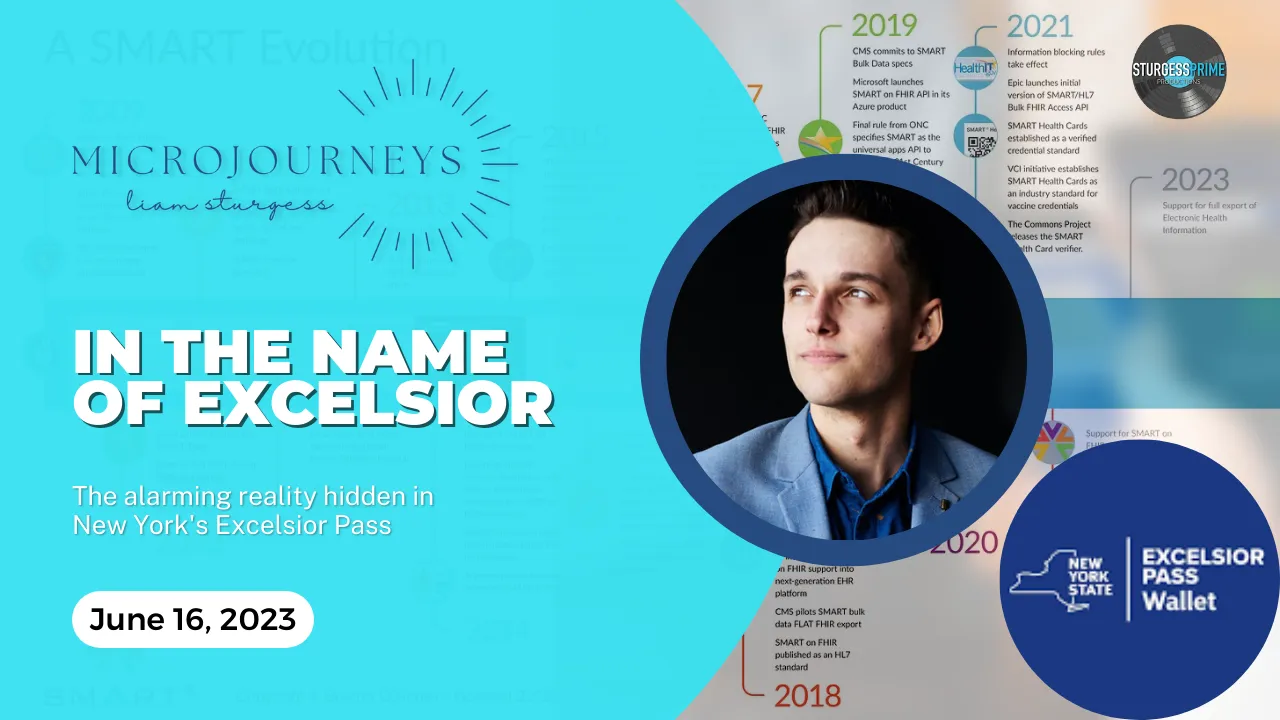Originally published on Substack by Microjourneys
Introduction
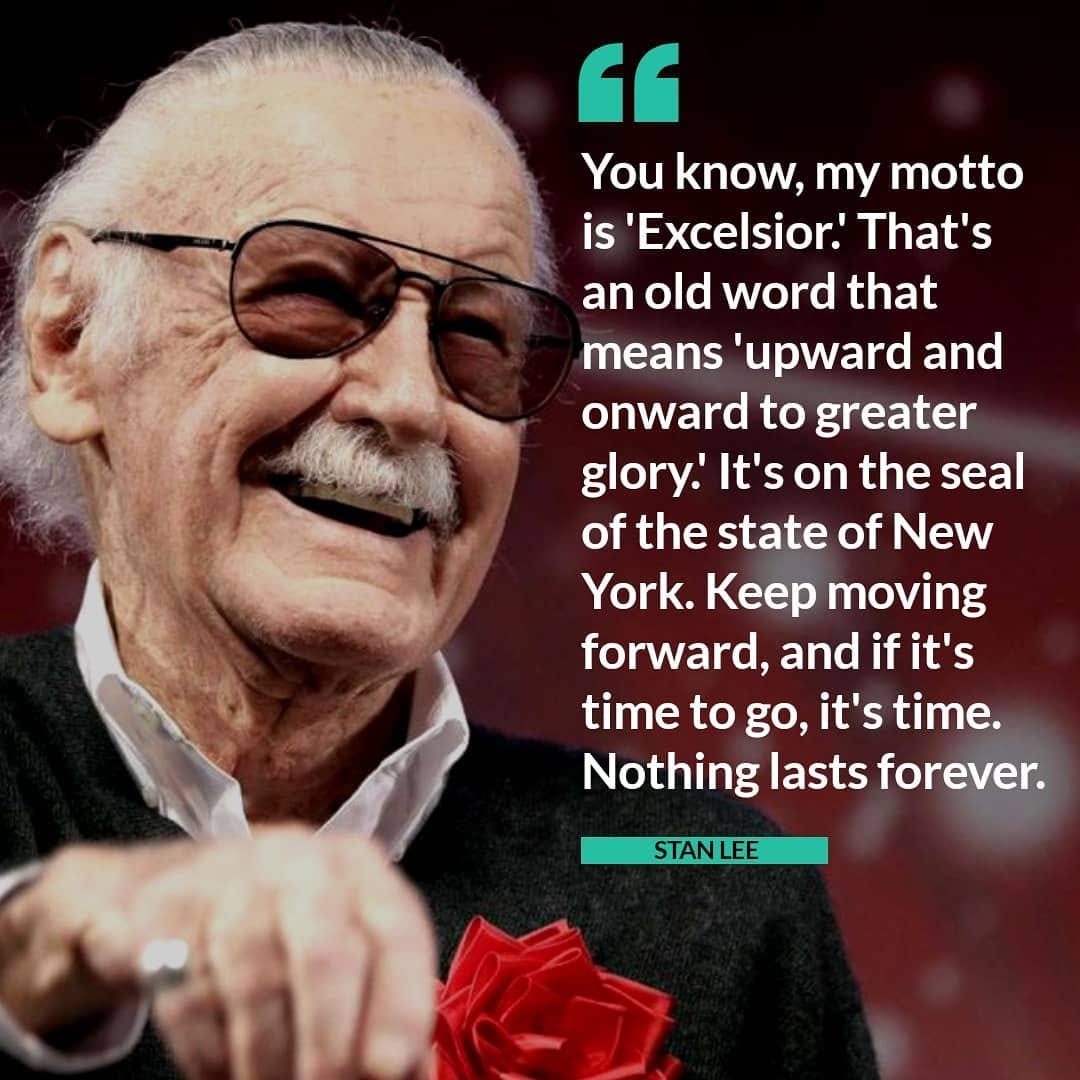
Excelsior!
It’s a word I associate primarily with one of my childhood heroes, the late Stan Lee. Throughout his tenure as a writer and eventual Editor-in-Chief of Marvel Comics, Lee introduced the world to such superheroes as Spider-Man, Iron Man, and the X-Men.

Superheroes had already been around in comic books for several decades, popularized in the United States during World War II as a way to bolster spirits while young men fought the Nazis, fascist Italy and Imperial Japan overseas.1 Superman’s bulletproof skin and Swiss army knife of superpowers, Captain America’s flag-waving patriotism, Wonder Woman’s suave feminine force — these images remain seared into history as examples of humanity at its maximum potential. Adolf Hitler never stood a chance, so long as Americans aspired to this standard of hero. A standard of perfection.

But Stan Lee had a vision for a different kind of hero. Rather than limiting himself to invincible aliens or uber-rich techies dressed in bat suits, Lee told stories of a teenager whose uncle was killed because of his arrogance. Stories of a man whose failure to manage his anger every person (and building) around him at risk. Of a whole class of people segregated and oppressed because they were genetically “different.” Yes, Lee brought to the world characters that you and I can relate to. Not strictly in the details of their backstory, but in their journey of coming to terms with their demons and finding a way to become a force of good in spite of them.
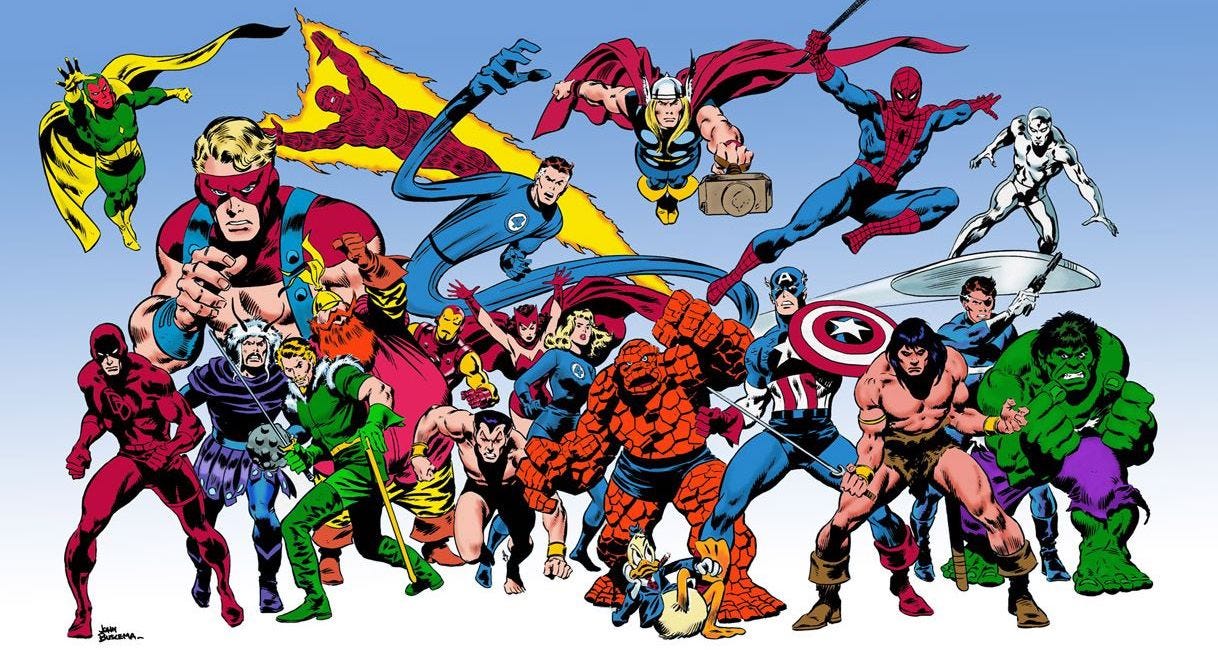
Supermen don’t have problems, but a kid from Queens does.
Excelsior!
This was Stan Lee’s catchphrase, and for good reason. In his words, “Excelsior” means “upward and onward to greater glory.”2 Other sources define it as meaning “loftier, yet higher, more elevated; ever upward” — to surpass, to excel.3 Lee’s vision was one where all people, no matter who you are or where you come from, can reach ever higher and achieve ever more.
Excelsior is also the official motto of the State of New York. I wonder what this New York legend would think of how the last few years have gone in the streets he used to roam.
The Excelsior Pass
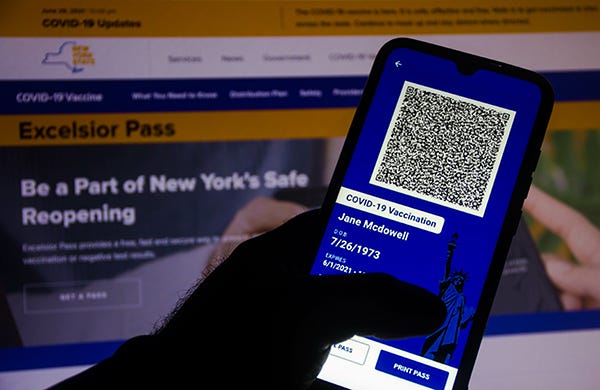
The Excelsior Pass was the name given to New York State’s COVID-19 vaccine passport system. It it officially described as a “secure, digital proof of COVID-19 vaccination or negative test results.”4
Former New York Governor Andrew Cuomo first discussed plans around what would become the Excelsior Pass during his 2021 “State of the State” address on January 10, 2021.5 “The vaccine will end the COVID crisis,” Cuomo stated. “We must vaccinate 70-90% of our twenty million New Yorkers.”
“We must also learn the glaring and costly lessons of America’s failed public health system, so we are better prepared for the next time. And as we all now should realize… there will be a next time.”
After turning to other topics, such as the state’s transition to ‘green energy’, Cuomo returned to the COVID-19 vaccine, dramatically increasing his uptake target. “Most pressing for the immediate future: we must vaccinate all New Yorkers.”
On March 2, 2021, Cuomo announced the launch of a pilot program to test out the new rapid test and vaccine passport system at Madison Square Garden and Barclays Center. The app was then officially launched to the wider public on March 26, 2021.6
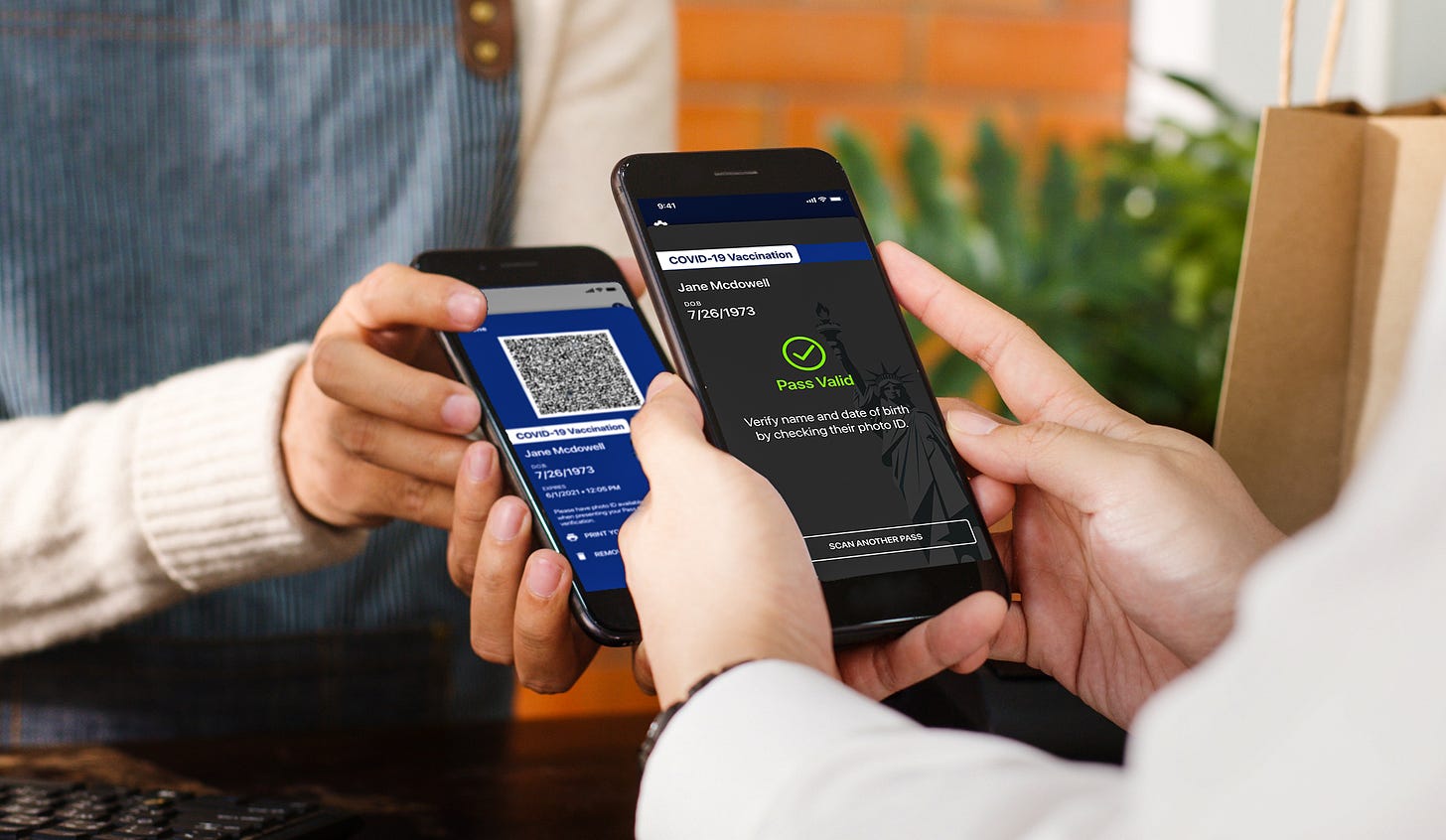
Development
As with Mastercard’s “Wellness Pass” program (discussed in my previous Microjourney), development for the Excelsior Pass actually predates the COVID-19 era. As reported by the Times Union:7
New York’s expanding contract with the two firms actually began before the pandemic, in September 2019. The broadly worded agreement covered work “transforming or reengineering government business models and operations.” State officials agreed to spend up to $59.5 million over the ensuing five years for the services of Boston Consulting Group and Deloitte, whichever organization was better suited for the work on specific projects.
The contract would go on to be amended during the pandemic, although tracking those changes is complicated by the fact that the state comptroller’s office lacks copies of the various iterations due to the COVID interruption in its oversight role.
Boston Consulting Group (BCG) and Deloitte are names that continue to crop up throughout investigations into the COVID-19 response, across the United States, Canada and beyond. They are both partner organizations of the World Economic Forum.8, 9
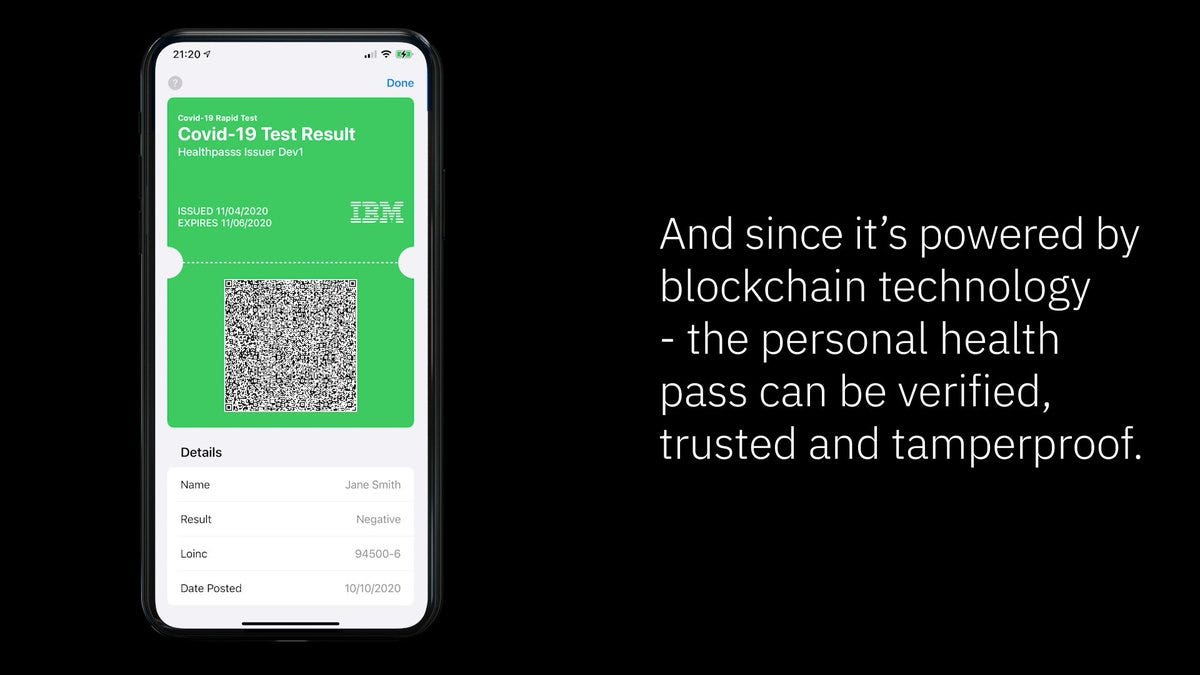
Another WEF partner attached to the Excelsior Pass project is IBM,10 the firm hired to build and manage the passport application itself.11 IBM built the Excelsior Pass on top of their “IBM Digital Health Pass” platform, which had been rolled out in response to the declared COVID-19 pandemic. According to Katia Moskvitch, writing for Inside IBM Research on Medium:12
It was in March 2020, at the start of the COVID-19 pandemic, when Elli Androulaki first thought about creating a digital health pass. …
On a swiftly convened virtual meeting, the scientists presented a handful of ideas — and chose a blockchain-powered solution to securely verify a user’s health status while protecting their privacy.
The idea assumed people would get certifications of their health status, including PCR and antibody test results or vaccination status, from their healthcare providers. The obvious device to store and share the data would be mobile phones. But not everyone has a smartphone. To make the solution more widely accessible, they decided to also make it available in the form of a printed QR code that could be scanned.
The IBM Digital Health Pass was born.
After apparently being conceived in March 2020, the pass was announced on August 25, and launched in a limited capacity on November 15.
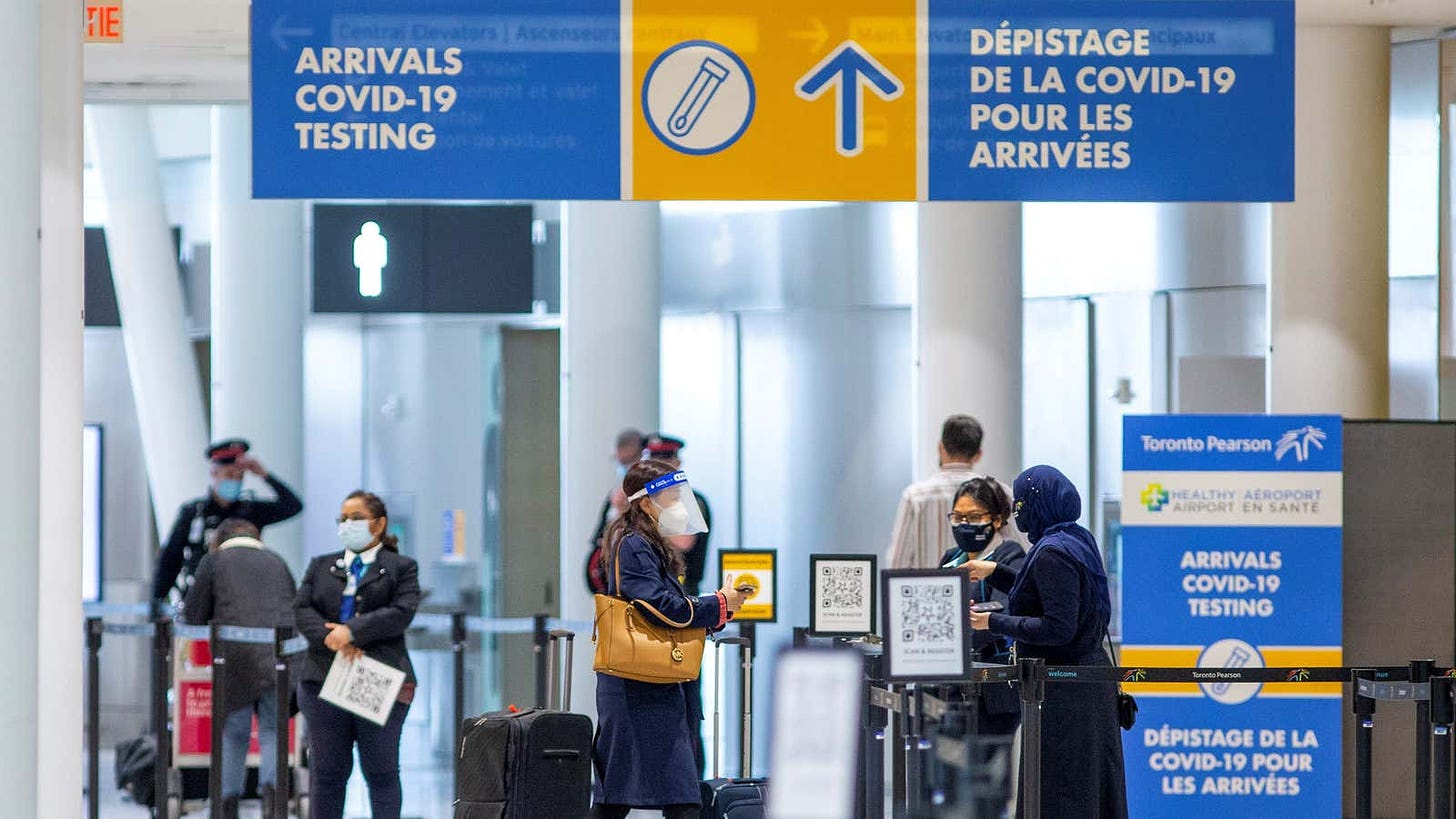
However, a July 21, 2021 article published in Quartz pushes the developmental timeline of IBM’s Health Pass back even earlier:13
Greg Land, IBM’s travel and transportation expert, believes the growing adoption of app-based health passes will energize initiatives to digitize all travel credentials which may one day make passport booklets obsolete.
“Even before the pandemic, we were starting to see long lines at airports and other venues and it made us think that we just have to find a way to take that digital transformation to the next level,” Land explains. “It’s sad that it’s taken a pandemic to get progress in building these standards around digital credentials. But I think what we’re going through right now, especially with airlines and other travel companies, is helping us realize the benefit of moving to digital IDs like passports or driver’s licenses.”

Indeed, contrary to dismissals such as the one we saw in the above Fortune article, IBM’s Health Pass was always intended to operate as a true passport — first as a complimentary system to store “health status,” and ideally replacing physical passports for travel altogether. And — to nobody’s surprise — the process of developing the IBM Digital Health Pass predated COVID-19, as was the case with the Mastercard Wellness Pass.
New York’s Excelsior Pass was not the only service that opted to build on IBM’s Digital Health Pass. As described in the July 2021 article, a booking company called Amadeus used by “over 450 airlines” signed up for the system, successfully tying IBM’s vaccine passport program to international air travel.
Excelsior Pass Plus
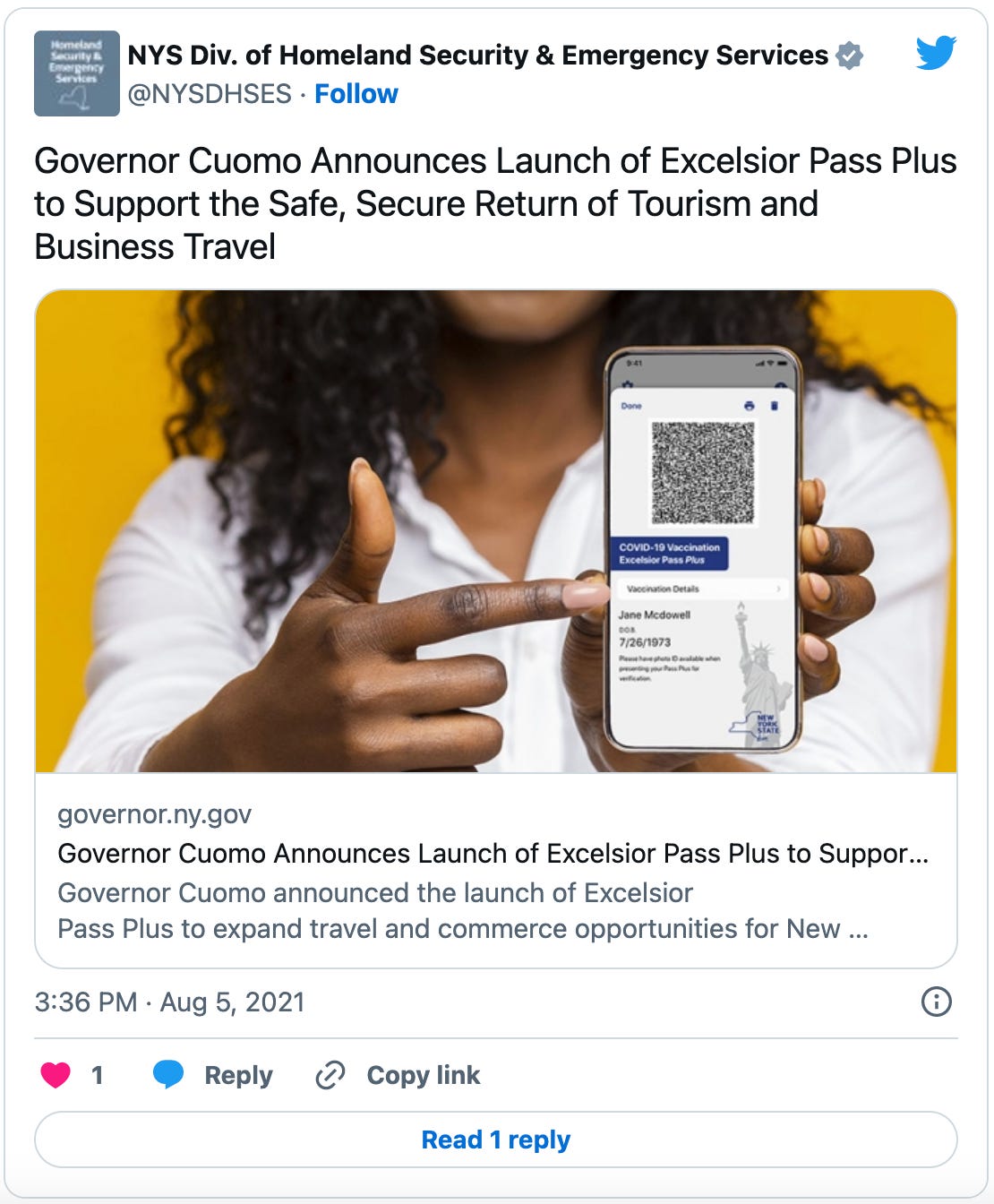
Of course, given that the Excelsior Pass was essentially just a New York-branded version of the IBM Digital Health Pass, the latter’s interconnectivity would naturally also become part of the former’s offerings.
Indeed, on August 5, 2021, Governor Cuomo announced the introduction of the “Excelsior Pass Plus” which would expand the program to be recognized by other states and internationally.14 Two specific programs were highlighted in the formal announcement: VeriFLY and the SMART Health Card Framework.15
VeriFLY
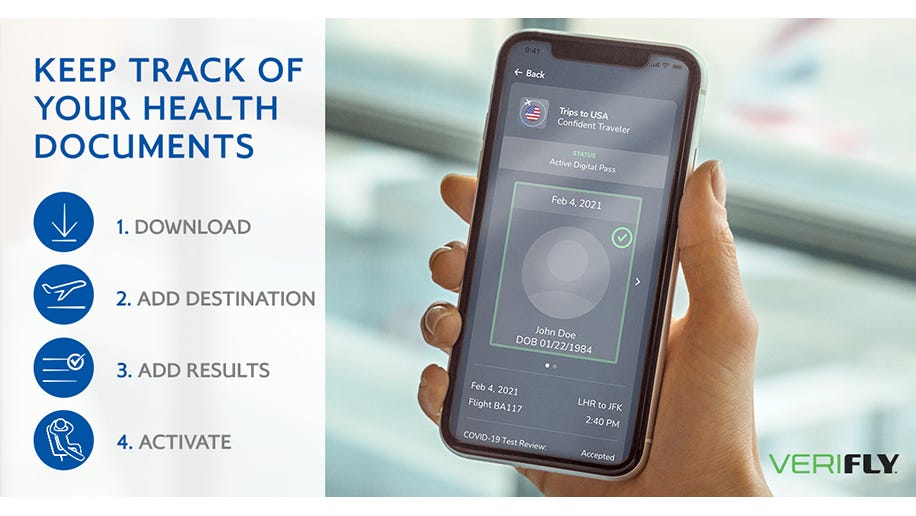
VeriFLY is a digital passport service developed by Daon, an international biometrics and digital identity company based in Fairfax, Virginia. From a May 2021 article published in One Mile at a Time:16
VeriFLY compiles real-time wellness information from self-certified health questionnaires and/or diagnostic COVID-19 test results from over 20,000 performing labs and provides digital badging, proof of test status for both antibody or viral testing, and (in the future) proof of vaccine. Our HIPAA-compliant solution removes the burden from organizations to structure agreements for lab results in multiple locations.
Users enjoy countless ways to acquire, verify, and assert their credentials—proof of health status, age, enrollment, citizenship, membership, reservations, and more.
Companies partnered with VeriFLY include:17
- Aer Lingus
- American Airlines
- British Airways
- Carnival Cruise Lines
- Holland America Line
- Hyatt
- Japan Airlines (JAL)
- Seabourn
- Viking Cruises
While this list currently only includes travel and hospitality companies, VeriFLY’s stated scope of operations includes far more than just travel credentials. In fact, with the mention of “citizenship” and the inclusion of biometric data, VeriFLY sounds an awful lot like Mastercard’s National Identity Smart Cards in Nigeria.
Speaking of Smart cards…
SMART Health IT
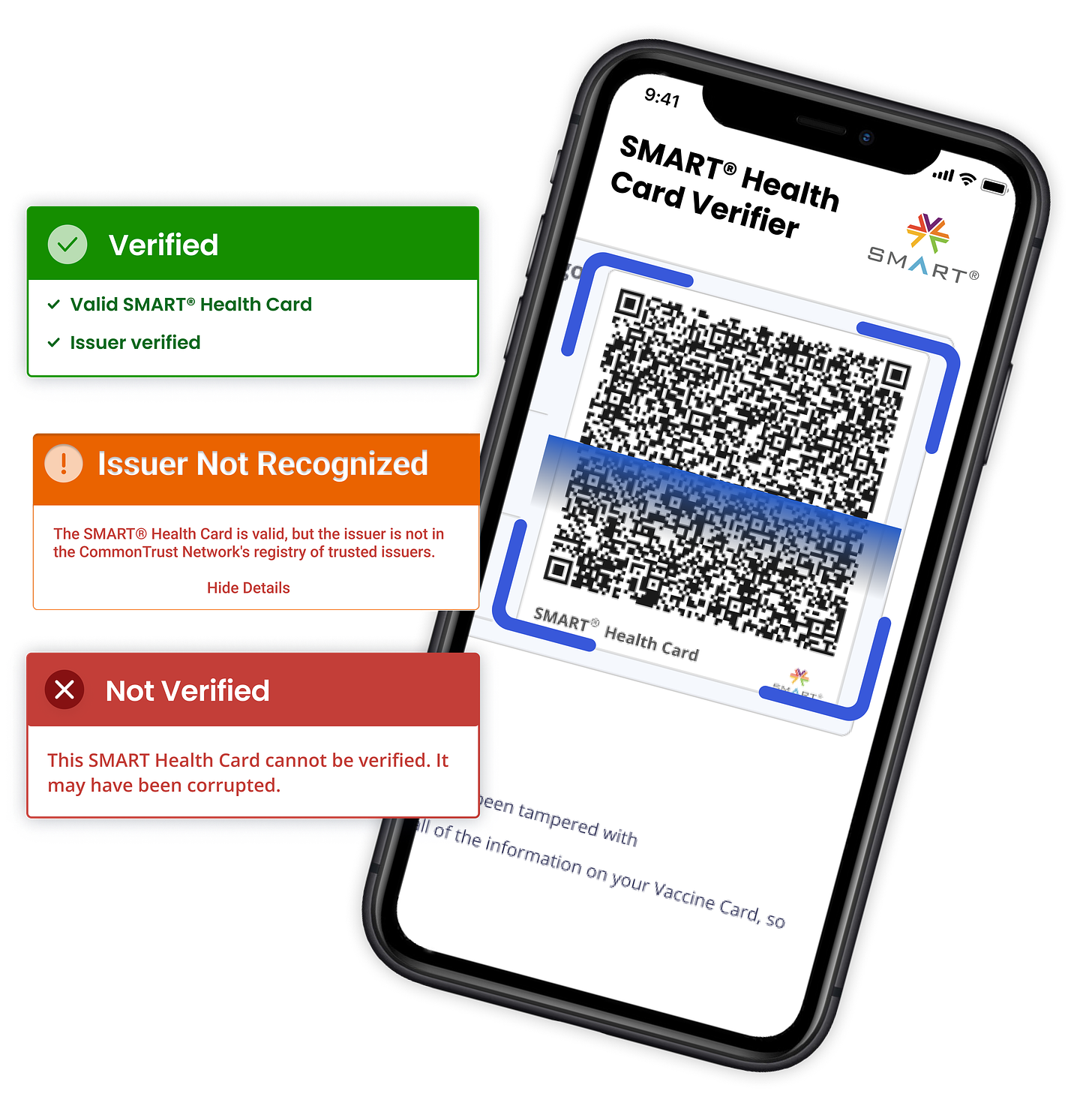
The second Excelsior Pass Plus integration Governor Cuomo announced was with the SMART Health Cards Framework:
New Yorkers will be able to display their Excelsior Pass Plus at hundreds of businesses and locations that require proof of vaccination, as well as when traveling to entities where SMART Health Cards are accepted. Excelsior Pass Plus, a result of the strategic partnership between New York State and VCI, will provide New Yorkers safe access to retrieve a secure, digital copy of their COVID-19 vaccination record using the SMART Health Cards Framework – making their interstate and international travel and commerce experiences safer, contact-less, and more seamless.
The SMART Health Card is a vaccine passport program developed by SMART Health IT and the Vaccine Credential Initiative (VCI).18
SMART Health IT is a project run out of the Computational Health Informatics Program (CHIP) at the Boston Children’s Hospital.19 According to the project’s website, it traces its origins back to a February 17, 2009 economic stimulus package approved by President Barack Obama which “included a $19 billion investment in health information technology.”20 This led to an initial grant of $15 million from the Office of the National Coordinator for Health Information Technology, a division of the United States Department of Health and Human Services (HHS), through their Strategic Health IT Advanced Research Projects (SHARP) program, intended to “directly confront” the “challenges and barriers to the adoption of electronic health records and other forms of health information technology.”21
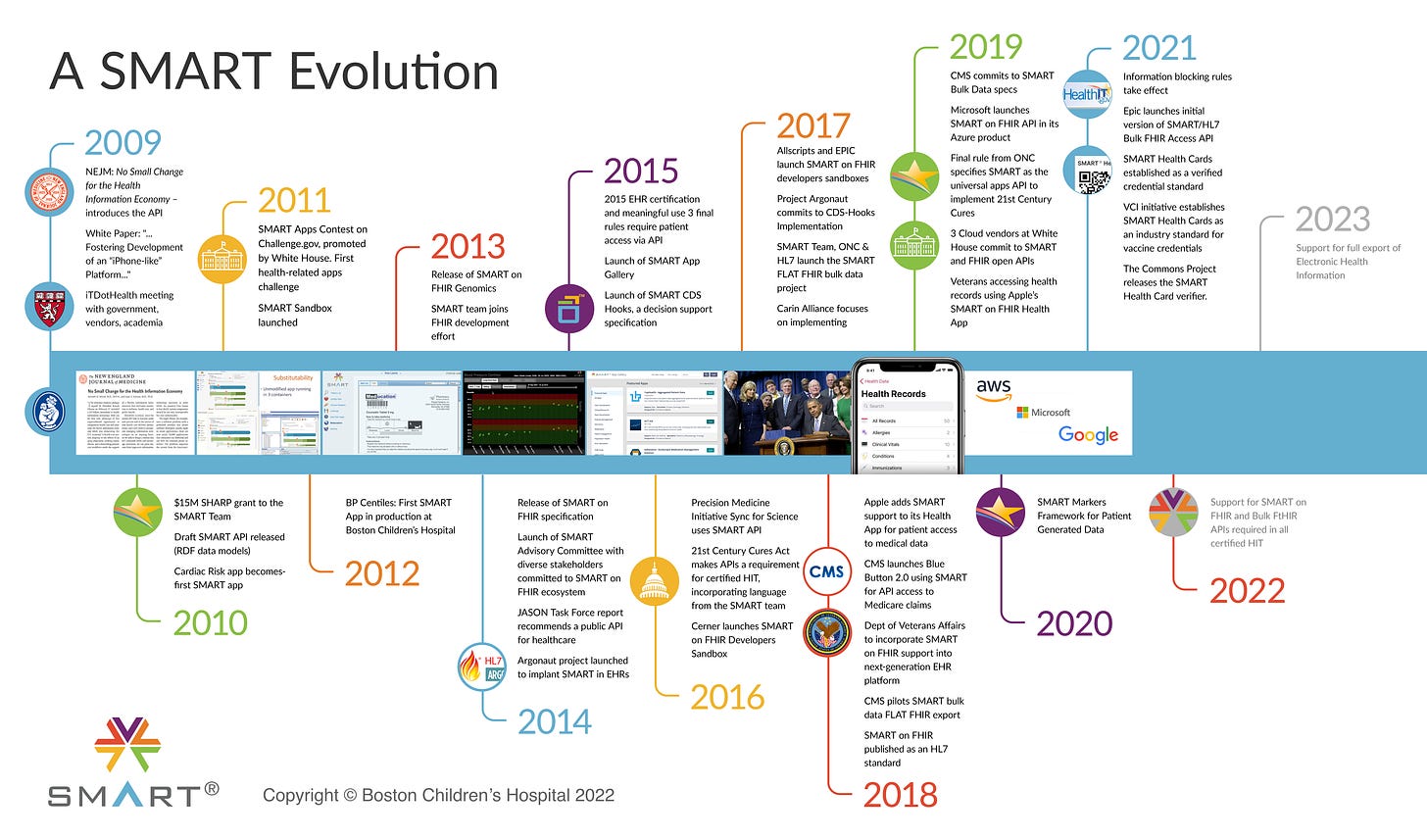
In 2013, the SMART team joined the effort to develop the Fast Healthcare Interoperability Resources (FHIR) standard, a “standard for exchanging healthcare information electronically” incubated by a non-profit organization called Health Level 7 International (HL7).22 Development of FHIR began the year prior in 2012 “in response to market needs for faster, easier, and better methods to exchange the rapidly growing amount health data.”23 SMART Health IT’s website describes FHIR as a standard to enable “push button” population health.
Health Level Seven (HL7) International
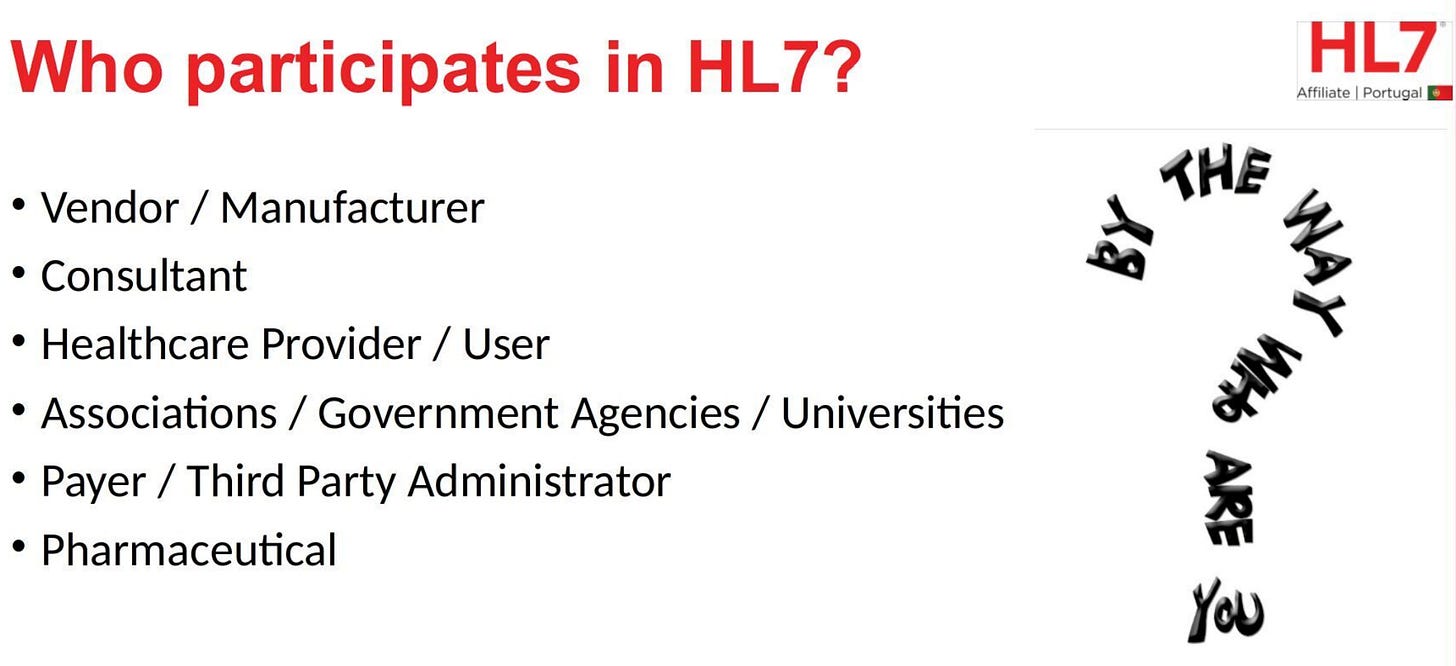
Notable member organizations of HL7 include:24, 25, 26
- American Heart Association
- American Immunization Registry Association
- Deloitte
- IBM
- Merck
- Microsoft
- National Cancer Institute
- National Institute of Standards and Technology (NIST)
- Pharmaceutical and Medical Devices Agency (Japan’s equivalent of the FDA)
- United States Social Security Administration
…as well as many other state-level health agencies. HL7 further discloses “benefactor-level” members, which include:27, 28
- American Medical Association
- Centers for Disease Control and Prevention (CDC)
- Eli Lilly
- European Medicines Agency
- Food and Drug Administration (FDA)
- GlaxoSmithKline
- Lockheed Martin
- National Health Service (NHS)
- Novartis
- Office of the National Coordinator for Health Information Technology
- Oracle
- Pfizer
- Thomson Reuters
- United States Department of Veterans Affairs
This is an eclectic yet predictable blend of corporations and government agencies, creating a robust public-private partnership that spans pharmaceutical companies, mass media, military contractors, big tech and regulatory agencies.
21st Century Cures Act
Working alongside HL7 International, the SMART Health IT team successfully lobbied both the United States Congress and the Department of Health and Human Services in order to pass the 21st Century Cures Act in 2016.29 This bill instructed the Office of the National Coordinator for Health Information Technology and HHS to develop and introduce a number of standards to facilitate “the secure exchange of health information between networks.”30
But that’s not all the 21st Century Cures Act did. Additional actions ordered to be taken included:
- Funded the Precision Medicine Initiative to accelerate development of “genetic medicines”;31
- Funded the Brain Research Through Advancing Innovative Neurotechnologies (BRAIN) Initiative, a continuation of the Human Genome Project.32 The initiative was co-founded by George Church, whose research into genetics, cloning and gene editing was funded for several years by Jeffrey Epstein;33, 34
- Section 2034: “HHS and the NIH must review and revise policies, including policies on conflicts of interest and laboratory animals, to reduce the administrative burden on researchers while maintaining the integrity and credibility of research findings.”
- Section 3012: “The FDA may permit the sponsors of new medications that target genes or variant proteins to treat rare, serious conditions to rely upon information submitted for an approved medication that uses the same technology.”
- Section 3024: “Clinical testing of investigational medical devices and drugs no longer requires the informed consent of the subjects if the testing poses no more than minimal risk to the subjects and includes safeguards.”
- Section 3033: “Upon request, the FDA must facilitate development and expedite review of regenerative advanced therapies, including cell therapies, therapeutic tissue engineering products, and human cell and tissue products. For a therapy to be eligible, there must be preliminary clinical evidence that the therapy has the potential to address an unmet medical need for a serious condition.”
- Section 3038: “The FDA may not determine that a combination product is a drug or biological product solely because the product has a chemical action. (Combination products are regulated based on their primary mode of action.)… The FDA must: (1) issue guidance that describes the process and best practices for review of combination products, and (2) propose that certain types of combination products may adopt good manufacturing practices that vary from requirements in regulations.”
- Section 3075: “The bill revises provisions regarding: (1) FDA screening of the Adverse Event Reporting System, and (2) evaluation of elements to assure safe use of drugs.”
- Section 3081: “HHS must ensure the issuance of timely and accurate guidelines regarding the use of medical products for countering public health emergencies or material threats.”
- Section 3084: “BARDA may enter an agreement with an independent, nongovernmental nonprofit to foster and accelerate the development and innovation of medical countermeasures and related technologies. BARDA must direct and oversee the nonprofit’s work and ensure transparency and accountability.”
- Section 3085: “BARDA’s procurement of medical countermeasures no longer requires Presidential approval or an agreement between HHS and the Department of Homeland Security.”
- Section 3086: “The FDA must award, upon approval, a priority review voucher to the sponsor of a drug or biological product that: (1) is a significant improvement in the prevention, diagnosis, or treatment of a serious condition; and (2) can be used as a medical countermeasure to a material threat. The transferable voucher entitles the holder to have an application for a new medication acted upon by the FDA within six months. The FDA may not issue vouchers after FY2023.”
- Section 3091: “The Advisory Committee on Immunization Practices must: (1) consider the use of newly licensed vaccines at each regularly scheduled meeting, and (2) make timely recommendations for vaccines designated as breakthrough therapies and vaccines that could be used in a public health emergency.”
- Section 3093: “HHS must: (1) report on ways to promote innovation in the development of vaccines, and (2) revise the Vaccine Injury Table to include information on vaccines recommended by the CDC for pregnant women. A mother and child are individually considered for compensation for a vaccine injury from a vaccine administered during pregnancy.”
- Section 4001: “This bill amends the Health Information Technology for Economic and Clinical Health Act to require HHS to establish a goal, develop a strategy, and make recommendations to reduce regulatory or administrative burdens relating to the use of electronic health records (EHR).”
- Section 4002: “The bill requires developers of health IT, for their health IT to be certified, to meet certain requirements, including that the developer not engage in information blocking, which is preventing, discouraging, or interfering with the access, exchange, or use of information.”
- Section 5009: “The bill reduces funding for the Prevention and Public Health Fund for FY2018-FY2024.”
- Section 5010: “The Department of Energy must sell crude oil from the Strategic Petroleum Reserve. The bill reduces the minimum amount of oil that must be kept in the reserve under certain circumstances that allow for a drawdown.”
Beyond simply lobbying the government to include provisions favourable to SMART Health IT’s health credential program, they appear to have participated in implementing a wide variety of fundamental changes to regulatory law which were necessary in order to rush through the experimental COVID-19 vaccines just four short years later. Of course, the bill also mandates the standardization of health data through a process of mass digitization, across private industry and the government itself.
A report co-published in December 2017 by SMART and the Office of the National Coordinator for Health Information Technology describes the outcome of the 21st Century Cures Act as “an opportunity to create the learning healthcare system,” which “requires the ability to aggregate and analyze data at a population level.”35 The report summarized a meeting whose participants also included representatives from Amazon, Google Brain, Mount Sinai Health System and Rush University Medical Center, among others.
In 2019, the Office of the National Coordinator for Health Information Technology published the so-called “final rule,” specifying the SMART framework as the standard to satisfy the requirements of the 21st Century Cures Act.36 In their own words:
The SMART team successfully lobbied for an API requirement in the 21st Century Cures Act. Major HHS rules out of CMS and the ONC are implementing the Cures provisions and making SMART the law of the land.
Thus, the SMART Health Framework was cemented into U.S. law.
Vaccine Credential Initiative

On January 14, 2021, the MITRE Corporation announced the launch of a new project called the Vaccination Credential Initiative (VCI). According to the press release from the “broad coalition of health and technology leaders”, the VCI was formed with the promise of “empowering individuals with digital access to their vaccination records based on open, interoperable standards.”37
VCI coalition members are working to enable digital access to vaccination records using the open, interoperable SMART Health Cards specification, based on W3C Verifiable Credential and HL7 FHIR standards.
Members of the VCI at the time of launch included the CARIN Alliance, the Commons Project Foundation, Mayo Clinic, Microsoft, MITRE, Oracle and Salesforce. This would soon expand to also include Apple, Amazon Web Services, the American Immunization Registry Association, the COVID Immunity Project, Daon (developer of VeriFLY), FIS (partnered with Steve Kirsch’s M10 Networks),38 Google, HL7 International, IBM, Palo Alto Networks, and Walmart.39, 40
But it doesn’t stop there. Also included as members are various regional, provincial and state governments, including:
- eHealth Saskatchewan
- Government of Aruba
- North Carolina Department of Health and Human Services (NCDHHS)
- Ontario Ministry of Health
- State of California
- State of Colorado
- State of New York
- Sydney Local Health District
I’m afraid, my friends, that this is where I find myself truly and palpably alarmed. If these government agencies signed on to the Vaccination Credential Initiative back at the very beginning of 2021, and all of these jurisdictions all subsequently rolled out a vaccine passport system, does that not inevitably suggest those seemingly-separate systems were all actually “interoperable” from the get go?
Before we seek to answer that horrifying question, I must expand the list further. On the dedicated website for the SMART Health Cards, we find a long list of “issuers.”41 A secondary list also exists on the VCI website.42

In addition to the jurisdictions already identified as members, the list of governments and organizations issuing SMART Health Cards includes:
- Alaska Department of Health Division of Public Health
- Arizona Department of Health Services
- Arkansas Department of Health
- California Department of Public Health
- CANImmunize (developed with funding by the Public Health Agency of Canada and endorsed by Pfizer)43, 44
- Cayman Islands Health Services Authority
- City of Philadelphia Department of Public Health
- Colorado Department of Public Health & Environment
- Connecticut Department of Public Health
- Cook County Community Vaccination Program
- County of Santa Clara Health System
- Delaware Health and Social Services Division of Public Health
- Federated States of Micronesia Department of Health and Social Affairs
- Government of Alberta
- Government of Manitoba
- Government of Quebec
- Guam Department of Public Health and Social Services
- Idaho Department of Health & Welfare
- Illinois Department of Public Health
- Kentucky Immunization Registry
- Los Angeles County Department of Health Services
- Marshall Islands Immunization Registry
- Maryland Department of Health Center for Immunization
- Massachusetts Immunization Information System
- Ministère de la santé et de l’Action Sociale du Senegal
- Ministry of Health and Welfare of Taiwan
- Ministry of Health, Labour and Welfare of Japan
- Mississippi State Department of Health
- MyMichigan Health
- Nevada Division of Public and Behavioral Health
- New Brunswick Department of Health Innovation
- New Jersey Department of Health
- New Mexico Immunization Program
- New York State Department of Health
- Newfoundland and Labrador Department of Health and Community Services
- Northwest Territories Department of Health and Social Services
- New South Wales Government
- Oregon Health Authority
- Prince Edward Island Department of Health and Wellness
- Public Health Agency of Canada
- Puerto Rico Innovation & Technology Service
- Republic of Palau
- Rhode Island Department of Health
- San Francisco Department of Public Health
- Utah Department of Health & Human Services
- Virginia Department of Health
- Washington State Department of Health
- Yukon Department of Health and Social Services
…and yes, of course, New York State’s Excelsior Pass.
Excelsior!
But there are many, many more. Is your hospital, public health agency, university or clinic on this full list, available on the Campfire Wiki?
Unfortunately, it turns out to be very, very easy to confirm whether this was an empty commitment on behalf of our governments, or a system actually put into action throughout 2021 and 2022.
Visiting the webpage for eHealth Saskatchewan’s COVID-19 Vaccination Record, one finds the following pair of images:45

Just above the QR code on the second image, there is a line of text that reads “SMART Health Cards QR Code” in English and French. Further down the page is an example of a printed copy of the SMART Health Card, complete with logos for the Province of Saskatchewan and the Government of Canada — and your personal health details, of course.
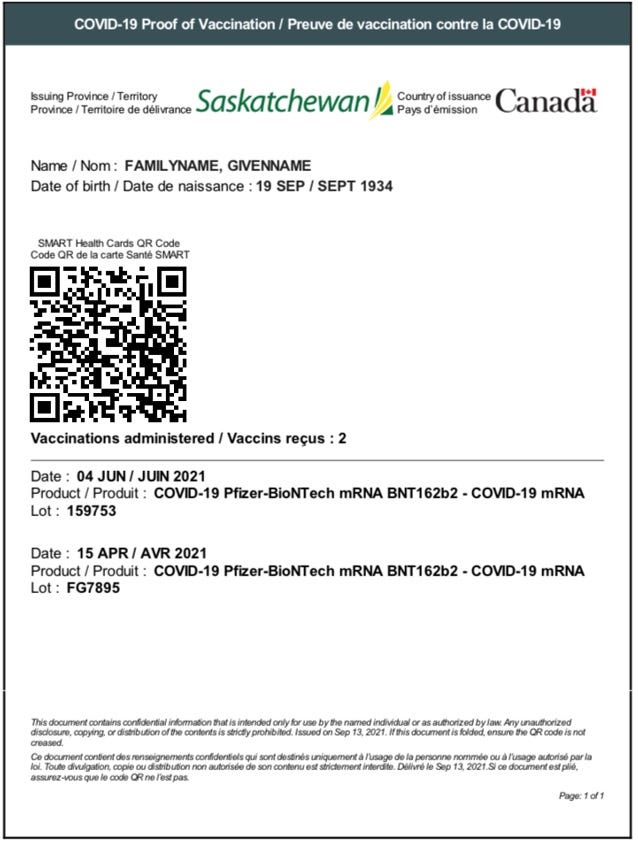
What about the Yukon, that happy little territory lodged beside Alaska? A government webpage titled “Sample proof of vaccination credential”46 allows you to download a preview, which looks awfully familiar.47
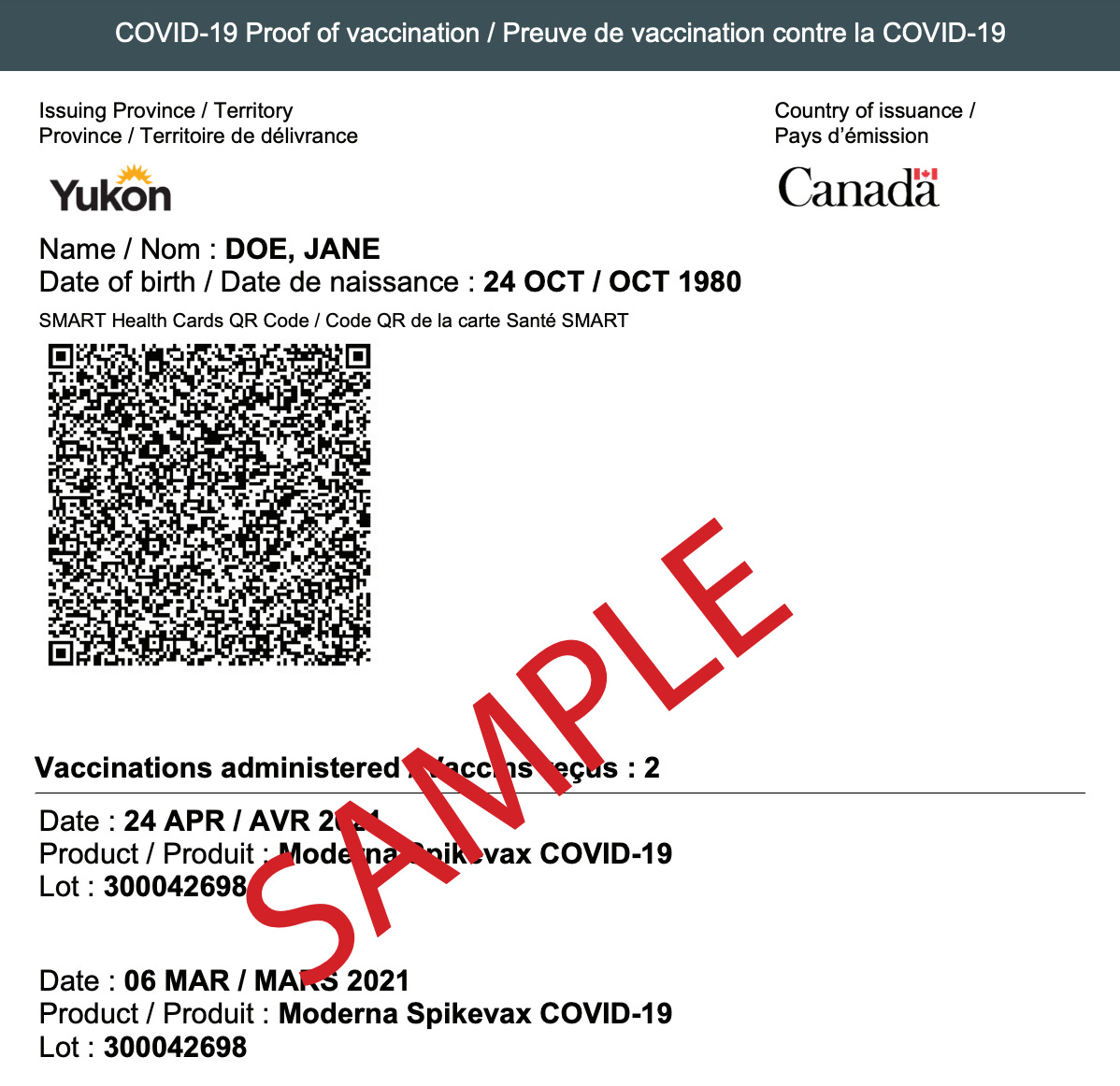
Now, you may have noticed that, for example, not all 13 Canadian provinces and territories were included on the list of members/issuers. What a relief! Could that mean my home province of British Columbia went a different direction after all?
Not so fast.
On the Government of British Columbia’s webpage titled “Proof of vaccination”,48 we are provided a similar sample to the ones from Saskatchewan and the Yukon — in fact, it is identical in all its features, including the “SMART Health Cards” text located with the QR code. I suppose that’s the point, isn’t it?
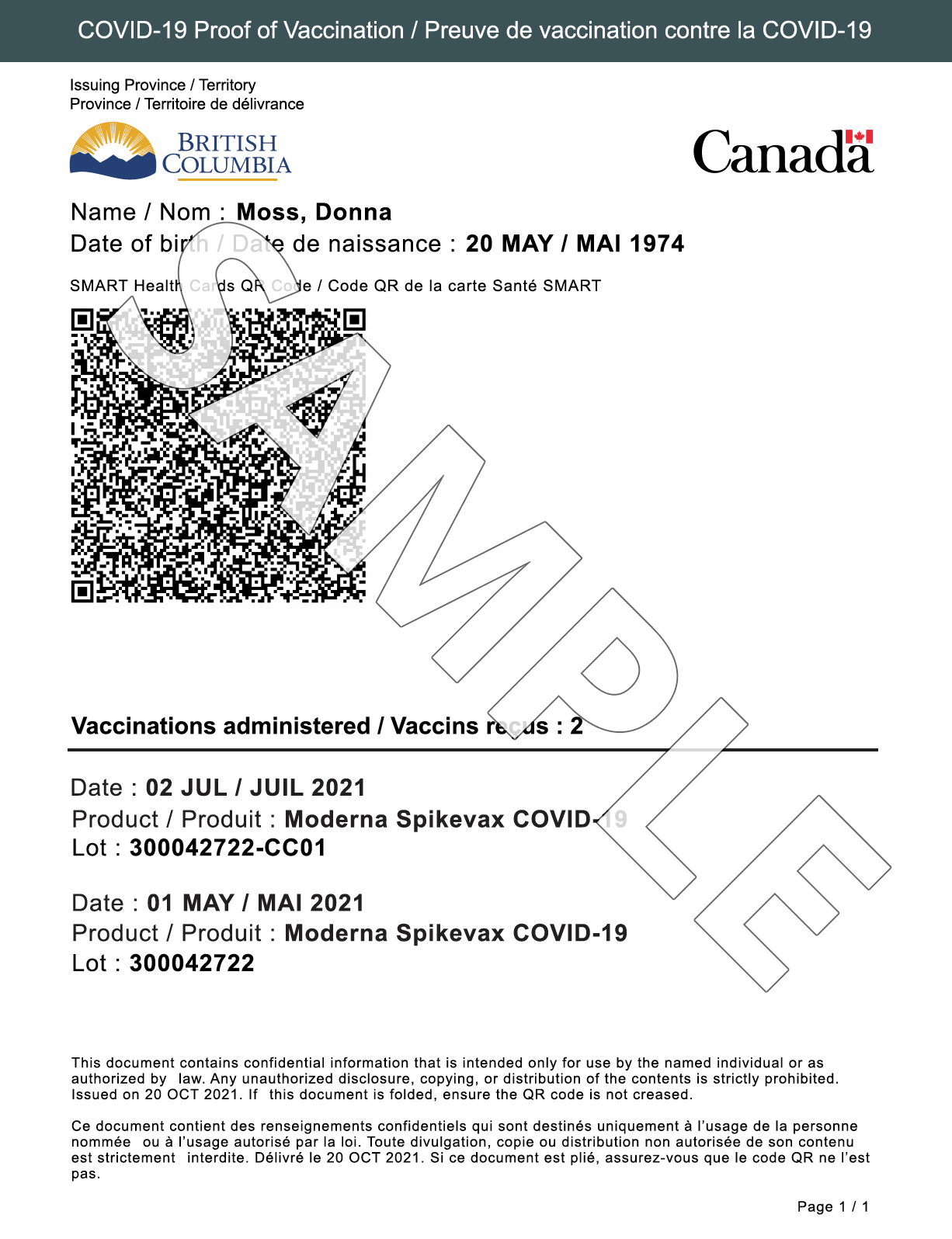
Indeed, according to the same webpage, “B.C. uses the SMART Health Card QR code format” as “a requirement of the federal government.”
National vaccine passport
Canada
The Public Health Agency of Canada helps fill in the knowledge gap here. On their webpage titled “COVID-19: Proof of vaccination in Canada”, PHAC explains that “the Canadian COVID-19 proof of vaccination uses the internationally recognized SMART Health Card specification.”49 The federal proof of vaccination “was developed by provinces and territories with support from the Government of Canada,” and is described as “a recognized, trusted document that has been shared with our international partners.”
There you have it. In their own words, the Government of Canada, along with the provincial and territorial governments, are officially hooked into to a vaccine passport system shared with unspecified “international partners”.
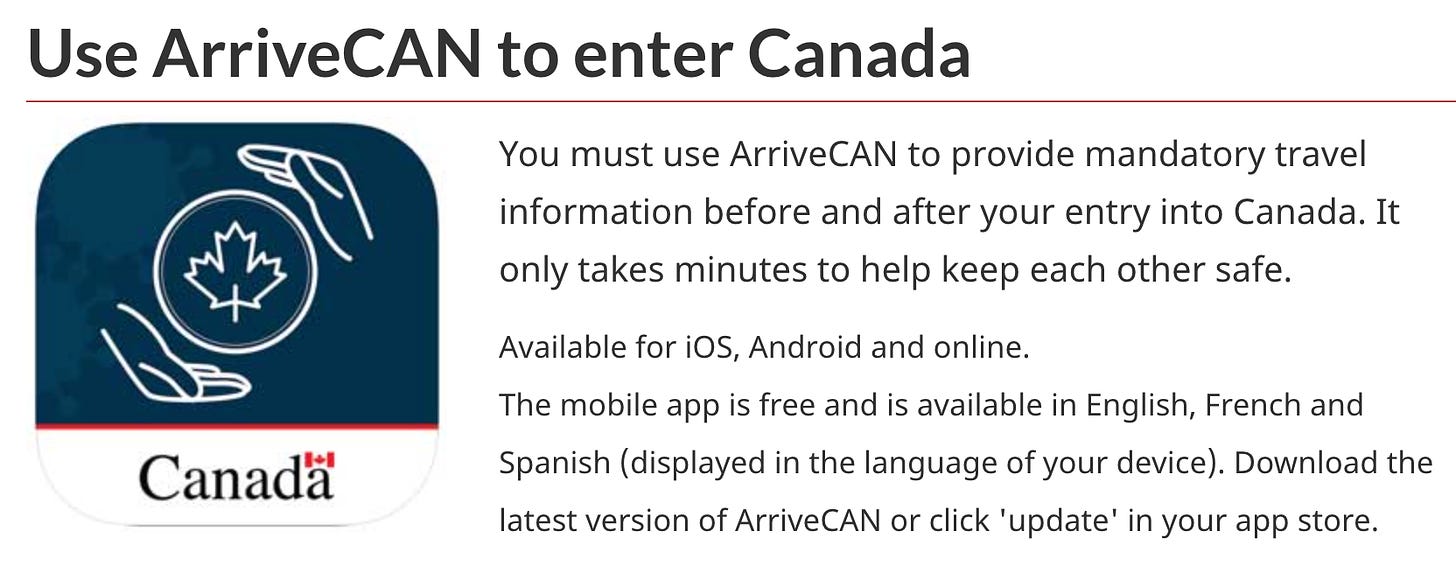
Then there’s the infamous ArriveCan, through which Canadian citizens were forced to submit “contact information and travel details,” your “vaccination information and pre-entry test results,” and a “quarantine plan.”50 Included in the border control web and mobile application’s exceptional $50+ million price tag was “$4.6 million (9%) to develop a proof of vaccination credential to authenticate and verify, in real time, using the industry standard ‘Smart Health Card,’ the traveller’s proof of vaccination delivered by provinces and territories, as well as international ones.”51
United States

On January 13, 2022, NBC News said the quiet part out loud. As written by David Ingram:52
Whether they realize it or not, about 200 million people in the United States now likely have access to a Covid-19 digital vaccine card.
The digital pass known as the SMART Health Card is voluntary and minimal by design to protect personal information. It has a person’s name, date of birth and the dates and brands of vaccination doses, all contained within a type of scannable bar code known as a QR code.
And after a relatively quiet start, it has built momentum in recent months as more states and companies have signed on, making it something of a de facto national digital vaccine card. …
Rather than a single app, the SMART Health Card is open-source computer code that anyone can use to ping a verified source of health data and produce the unique QR code. The digital cards are now widely available from more than 400 sources including states, pharmacies and health care organizations.
Within the article, Ingram calls back to a previous story of his titled “Paper beats app: Vaccine verification will likely be proven offline. Here’s why.” At the time of publication back on December 10, 2020, all sorts of folks seemed much more skeptical of the notion that a digital application would be realistic, stating that the “realities of medical records, privacy concerns and the virus itself mean efforts to build vaccine passport apps are unlikely to succeed in the coming months.”53
Ingram cited statements made by a number of representatives from groups interested in vaccine credentials, both in general and specific to COVID-19.
American Immunization Registry Association
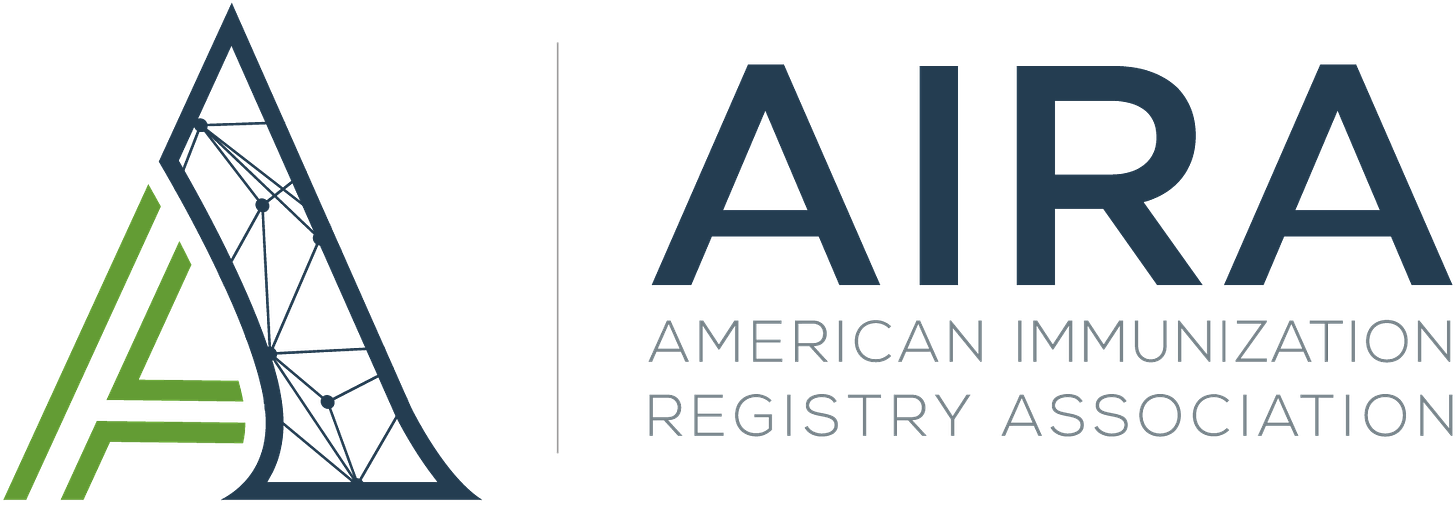
Rebecca Coyle, executive director of the American Immunization Registry Association (AIRA), said at the time that digital COVID-19 certificates were “something that almost no one can focus on right now.”
What Coyle didn’t mention is the AIRA’s membership at the time included the Centers for Disease Control and Prevention, the pharma-funded Immunization Partnership,54 the National Institute for Standards and Technology (NIST), the Pan-American Health Organization and the World Health Organization, with funding from GlaxoSmithKline and Sanofi.55
Very shortly after, they would receive additional funding from Amazon, IBM, and the Vaccination Credentials Initiative itself.56 Today, AIRA is also funded by Pfizer and Moderna, and proudly displays the SMART Health Card icon.57 It is a a member organization of both VCI and HL7 International, as well as the Adult Vaccine Access Coalition (alongside GSK, Johnson & Johnson, Medicago, Moderna, Novavax, and Pfizer).58
Vacmobile
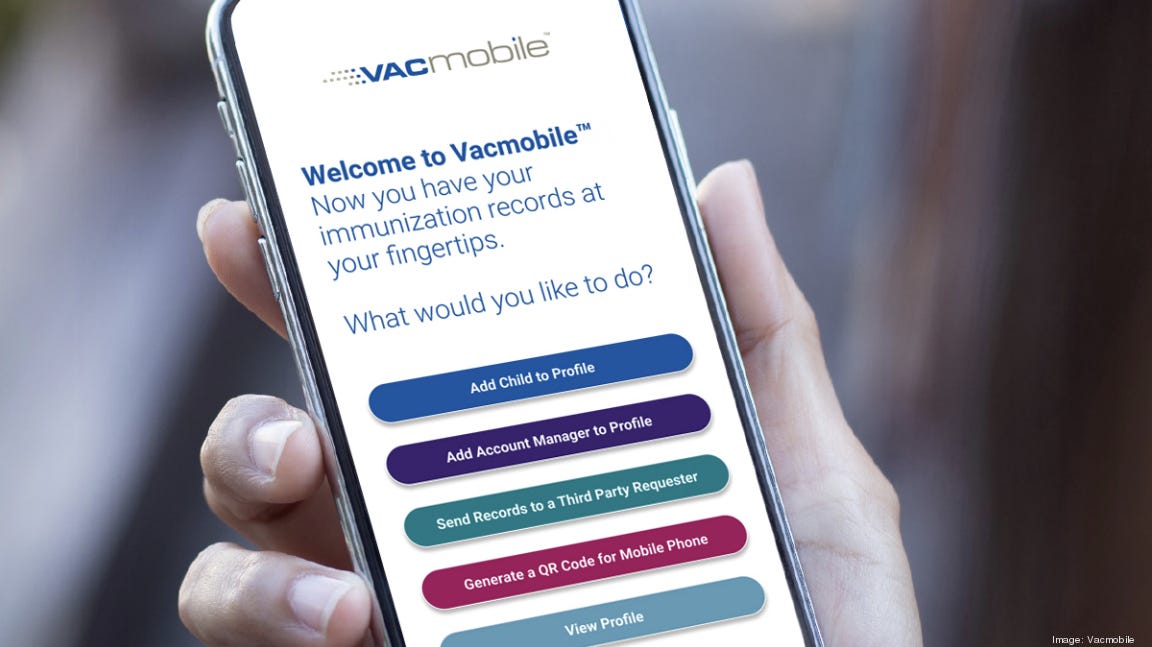
Billy Sparks, co-founder of Vacmobile, said that COVID-19 vaccine passports would be just like the paper-based ‘yellow cards’ given out after other immunizations. “It’s the same thing they did in 1918,” he said!
At the time, Vacmobile reportedly had an app of their own in testing, which “won’t be ready for a rollout with the potential first wave of U.S. vaccinations.” The below graphic was taken from the company’s website as it appeared on October 30, 2020. It features a notification for the fictional user to receive his 3rd HPV vaccination, for which he was apparently due.59
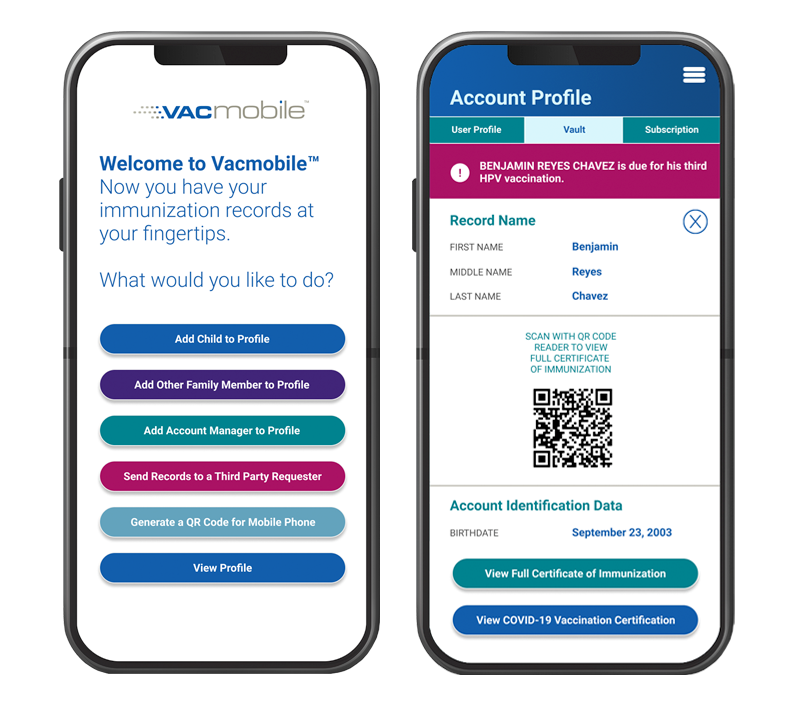
Funny, I thought HPV was a two-dose shot. Or in my case, one and done. I digress.
What was not included in the NBC News article is a mention of Sparks’ background as a United States Army Military Intelligence officer.60 This may fall more in the “interesting” column than “relevant,” but that is certainly something I clock.

Today, Vacmobile is “integrated in North America” through the SMART Health Cards system.61
Immunization Action Coalition
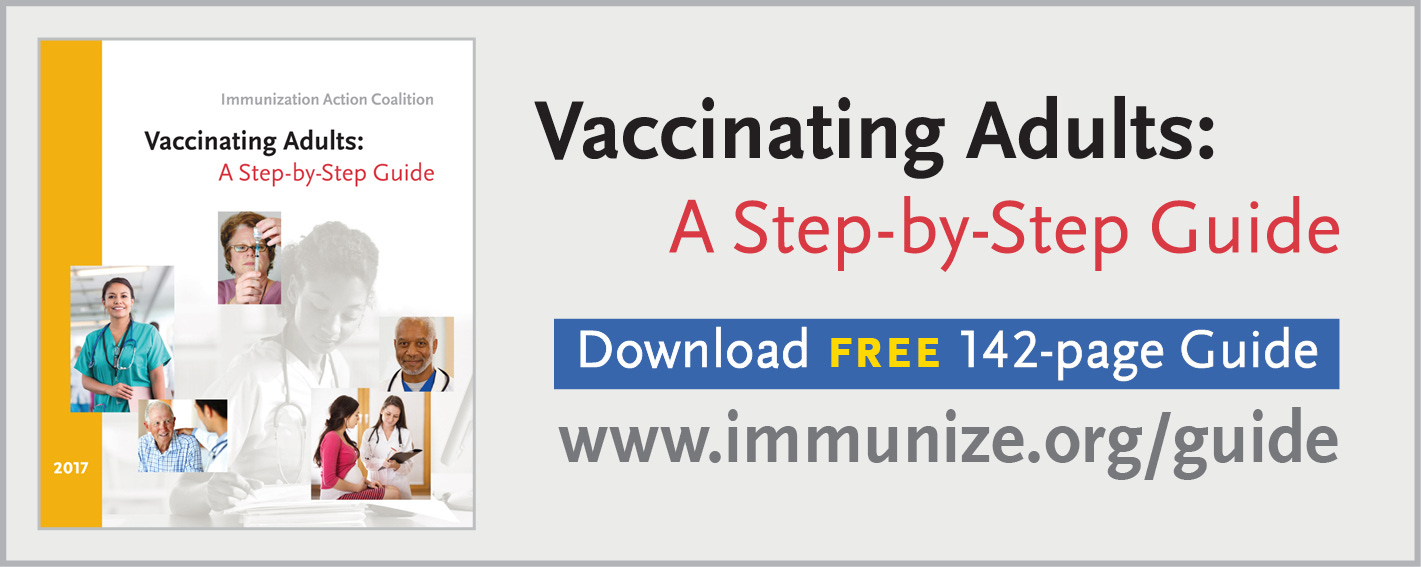
L.J. Tan, chief strategy officer for the Immunization Action Coalition (IAC), asked, “What’s the expiration date we’re going to put on that vaccination certificate?”
“We know we need more data,” he said, adding that the data might not be available until next summer. Digital immunization certificates, he said, are “a little premature.”
IAC’s attitude apparently shifted fast from where it was in December 2020. Their corporate supporters at the time included AstraZeneca, GlaxoSmithKline, Pfizer and Sanofi.62 Within less than a year, they were also joined by Janssen and Moderna.63
IAC participates as a member of the aforementioned Adult Vaccine Access Coalition, as well as the COVID-19 Vaccine Education and Equity Project, funded by Johnson & Johnson and Pfizer.64
The December 2020 article finishes by noting a number of related companies and initiatives attempting to push a standardized vaccine passport platform through, including the COVID-19 Credentials Initiative, Microsoft, Apple, and Google. Most importantly, however, is the mention of a group called The Commons Project. In fact, the absence of their name from NBC’s 2022 followup article highlighting the SMART Health Cards is notable, for a very good reason.
After all, they did help develop it.
The Commons Project
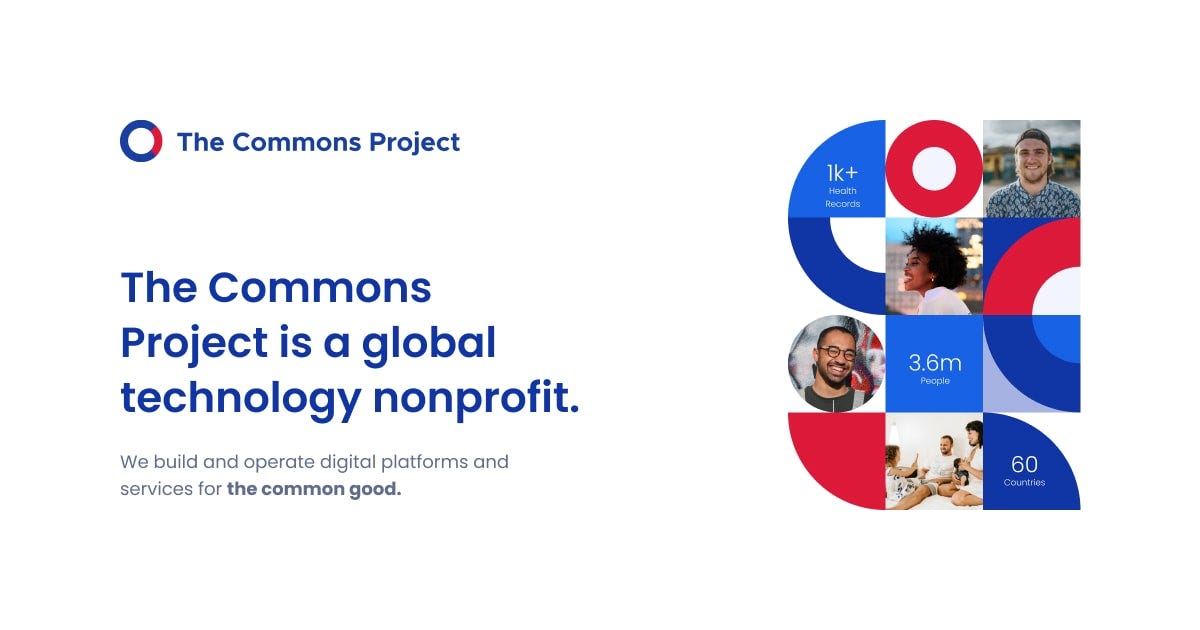
The Commons Project, officially The Commons Project Foundation, is a global non-profit organization based in Geneva, Switzerland. Ah yes, one might say all roads lead back to Geneva!
It was established in 2019 with funding from the Rockefeller Foundation.65
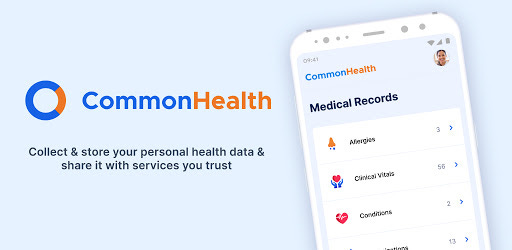
Their first project was CommonHealth, a health data management program. According to its website, the app “helps you collect and manage your personal health data and share it with the health services, organizations and apps you trust.”66
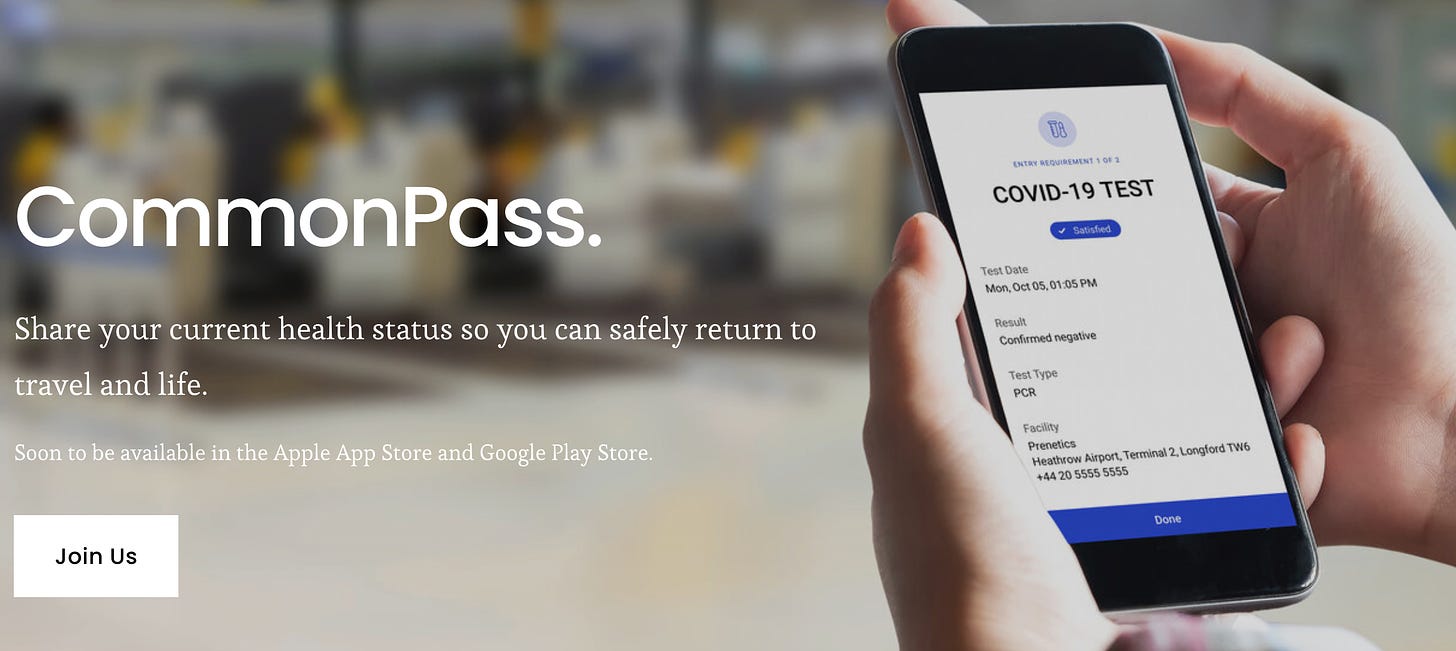
Following the declaration of the COVID-19 pandemic, The Commons Project did the only reasonable thing: they partnered with the World Economic Forum to develop the CommonPass, their own version of a vaccine passport.
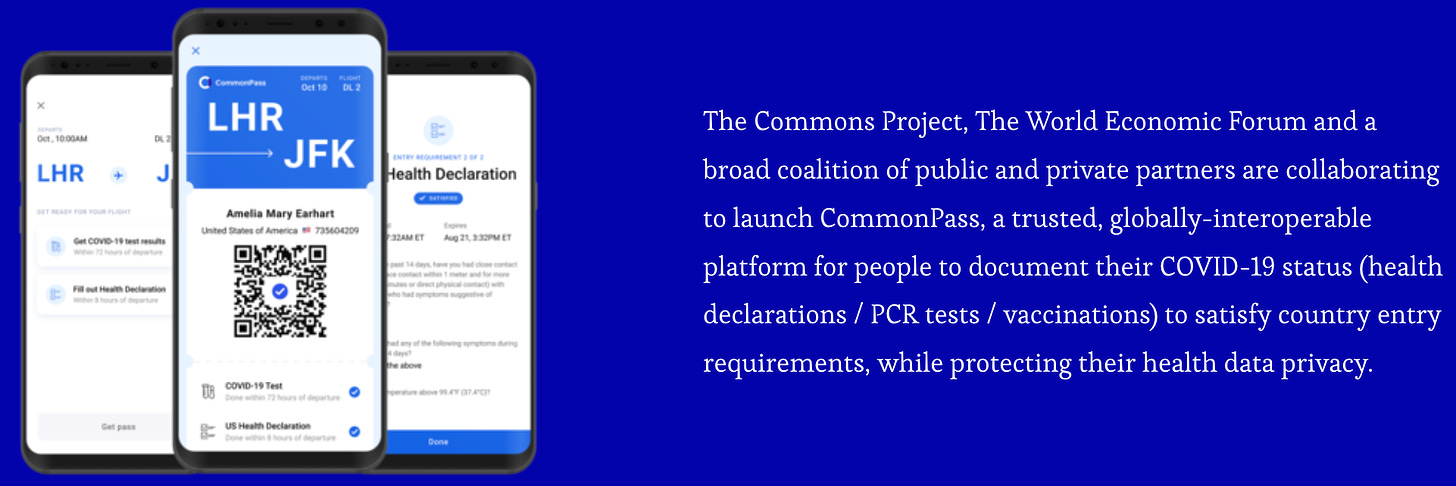
This was, in retrospect, a highly predictable next step, as replayed almost down to the exact detail in the cases of Mastercard and IBM. And just like the other passport platforms, CommonPass was designed to cooperate, being developed alongside “a broad coalition of public and private partners” to make it a “globally-interoperable platform for people to document their COVID-19 status”.67
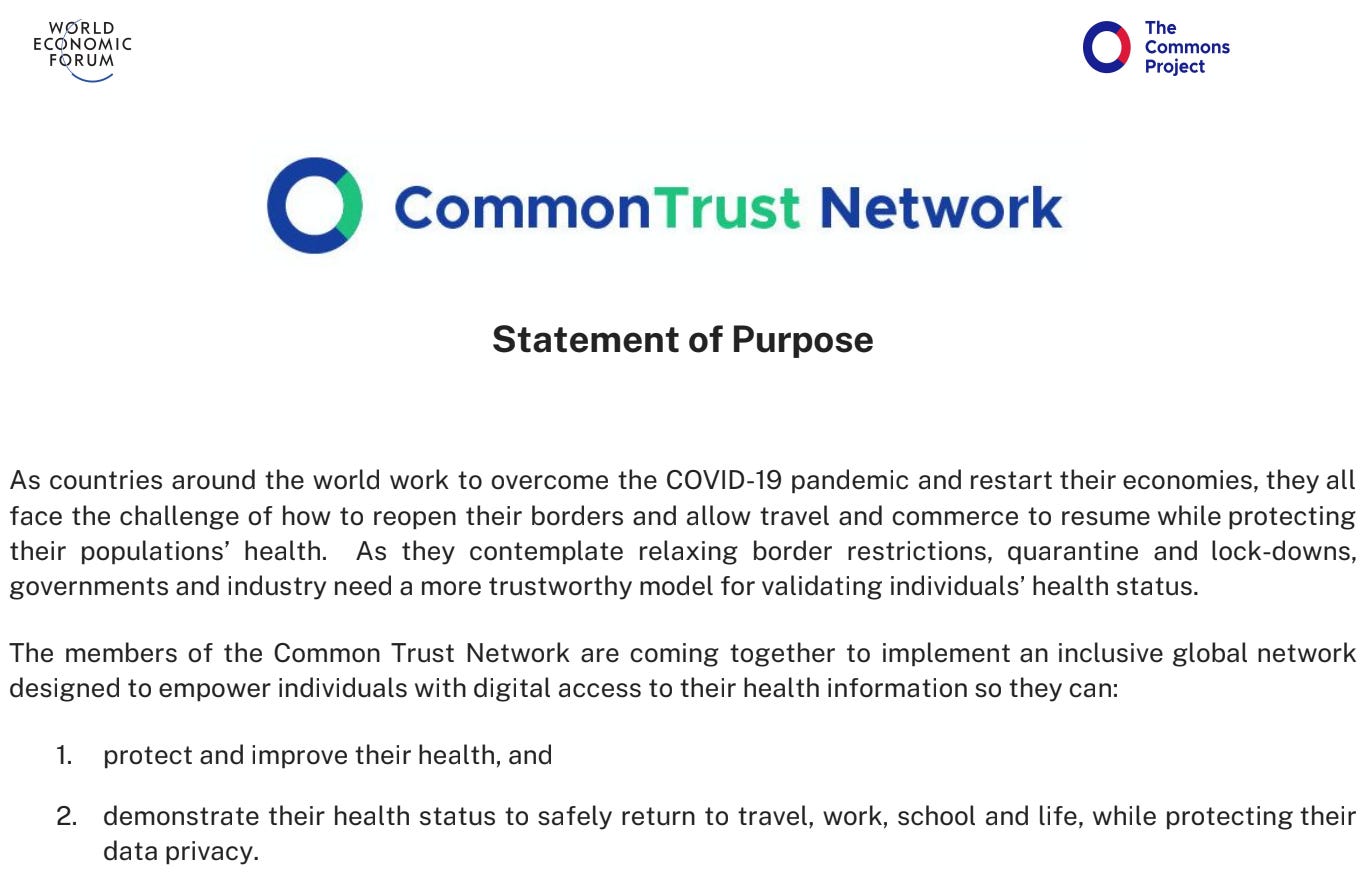
They also founded the CommonTrust Network, “an inclusive global network” which is enabled by “a global registry of trusted laboratory and vaccination data sources, standard formats for lab results and vaccination records, and standard tools to make those results and records digitally accessible.”68
The CommonPass was tested in October 2020 with the help of network partners Cathay Pacific Airways and United Airlines, under the supervision of the United States Customs and Border Protection (CBP), the Centers for Disease Control and Prevention (CDC) and the United Kingdom Border Force and Ministry for Transport.69
Partners of the CommonTrust Network include the Foundation for Innovative New Diagnostics (funded by the Bill & Melinda Gates Foundation, CDC, Gavi, Coalition for Epidemic Preparedness Innovations, Rockefeller Foundation, Unitaid and the WHO),70 IBM and Mastercard (speak of the devils).71, 72
Between CommonHealth, CommonPass and the CommonTrust Network, the Commons Project Foundation was ultimately working towards one primary cause: the worldwide implementation of the SMART Health Cards framework. Indeed, the Commons Project was among the founding members of the Vaccination Credentials Initiative, and serves on its organizational steering committee.
But it goes even further. JP Pollack, Co-founder and Chief Architect of the Commons Project, directly contributed on the development team building the SMART Health Cards as a “co-lead” of the VCI.73

Operationally, the Commons Project website seems to indicate that the SMART verifier app actually interfaces with the CommonTrust Network. If the issuing agency is not approved by the CommonTrust Network, the verifier app will return with a warning that the issuer is “not recognized.”74
CommonTrust Network verified means that the SMART Health Card was actually issued by the listed issuer (for example, Walmart or the State of California). It also means that the issuer is an authorized test or vaccination provider or a government operated registry of health information that is in the CommonTrust registry.
In other words, whenever you scan your “proof of vaccination” here in Canada, the World Economic Forum receives that information.
The final piece of the puzzle
It’s important to reiterate that while we are discussing the Excelsior Pass, IBM’s Digital Health Pass, Mastercard’s Wellness Pass, ArriveCAN, the CommonPass and the SMART Health Cards in the context of vaccine passports, it is painfully clear that this infrastructure has been developed for years in order to support the digital transition of all types of credential, health information, finance and government documentation. This is not speculation; this is the stated purpose of all these disparate projects and products, in slightly different terms.
In the end, however, it all comes back to what Mastercard introduced in Nigeria: an all-encompassing, and mandatory, digital identity. And it all happened in more or less perfect synchronicity around the declaration of the COVID-19 pandemic in 2020.
Conclusion
Next week, we will conclude this three-part vaccine passport/digital ID saga with a deep dive into ID2020, the World Bank Group’s Identification for Development (ID4D) Initiative, and several other entities operating at the supranational level of public-private governance.
Needless to say, this topic is heavy and risks painting a picture of inevitability. Sure, the momentum is strong and the corporate interests pushing this forward are historically not held accountable for their overreach and civil rights violations. But think of this in the context of your own life; the actions taken around you need not manifest as actions of your own. If you feel like you’re stuck to a train barreling into an ever more uncertain future, it may be time to reframe your position.
While it is physically impossible to stop it all at once, enough pressure applied to the brakes will eventually slow the train. But in the context of vaccine passports, or “proof of vaccination,” each person who complies with the system seals the fate of his or her friends and family. Without knowing it, each passive act of compliance further hammers in the nails of our collective future in shackles. In New York City, the Excelsior Pass and its associated “proof of vaccination” policies wound up, rather predictably, discriminating primarily against black and latino Americans. But it also led protesters from two politically hostile groups, Black Lives Matter and MAGA Republicans, to protest shoulder-to-shoulder in solidarity with Kyrie Irving when the NBA removed him for opposing the league’s vaccine mandate.
It’s not too late to be on the side of solidarity.
In his 1964 speech at UC Berkeley, Mario Savio offered this manifesto:
There is a time when the operation of the machine becomes so odious, makes you so sick at heart, that you can’t take part! You can’t even passively take part! And you’ve got to put your bodies upon the gears and upon the wheels … upon the levers, upon all the apparatus, and you’ve got to make it stop! And you’ve got to indicate to the people who run it, to the people who own it, that unless you’re free, the machine will be prevented from working at all!
References
- History Detectives. (2014). The Golden Age Of Comics. PBS. http://archive.today/2015.02.18-194453/http://www.pbs.org/opb/historydetectives/feature/the-golden-age-of-comics/ ↩︎
- Dudzik, A. (2019, November). Excelsior – “Upward and onward to greater glory!” Smithsonian Magazine. https://web.archive.org/web/20230614201821/https://photocontest.smithsonianmag.com/photocontest/detail/excelsior-upward-and-onward-to-greater-glory/ ↩︎
- Excelsior. (2023, May 13). Wiktionary. https://web.archive.org/web/20230601065604/http://en.wiktionary.org/wiki/excelsior ↩︎
- Excelsior Pass Frequently Asked Questions. New York Forward. Retrieved April 21, 2021, from http://archive.today/2021.04.21-171701/https://forward.ny.gov/excelsior-pass-frequently-asked-questions ↩︎
- Governor Cuomo Announces Pilot Program Testing the Excelsior Pass at Madison Square Garden and Barclays Center. (2021, March 2). Governor of New York. http://archive.today/2021.03.06-215033/https://www.governor.ny.gov/news/governor-cuomo-announces-pilot-program-testing-excelsior-pass-madison-square-garden-and ↩︎
- Governor Cuomo Announces Launch of Excelsior Pass to Help Fast-Track Reopening of Businesses and Entertainment Venues Statewide. (2021, March 26). Governor of New York. http://archive.today/2021.03.27-121149/https://www.governor.ny.gov/news/governor-cuomo-announces-launch-excelsior-pass-help-fast-track-reopening-businesses-and ↩︎
- Solomon, J. (2023, May 14). Excelsior Pass ballooned to $64 million and keeps rising. Times Union. http://archive.today/2023.05.15-152256/https://www.timesunion.com/state/article/excelsior-pass-ballooned-64-million-keeps-rising-18091575.php ↩︎
- BCG. World Economic Forum. Retrieved March 18, 2022, from http://archive.today/2022.03.18-003826/https://www.weforum.org/organizations/the-boston-consulting-group ↩︎
- Deloitte. World Economic Forum. Retrieved December 24, 2021, from http://archive.today/2021.12.24-210556/https://www.weforum.org/organizations/deloitte ↩︎
- IBM. World Economic Forum. Retrieved March 20, 2022, from http://archive.today/2022.03.20-163933/https://www.weforum.org/organizations/ibm-corporation ↩︎
- LaFleche, S. (2021, March 25). Digital Solutions Help Support New York State with Reopening Plans. IBM Newsroom. https://web.archive.org/web/20230602222643/https://newsroom.ibm.com/Digital-Solutions-Help-Support-New-York-State-with-Reopening-Plans ↩︎
- Moskvitch, K. (2021, March 31). Behind the Code: Making COVID-19 Digital Health Pass. Medium. http://archive.today/2023.02.11-131949/https://ibm-research.medium.com/behind-the-code-ibm-digital-health-pass-cc54cbae67bc ↩︎
- Quito, A. (2021, July 22). More than 450 airlines can now use IBM’s blockchain-based vaccine passport. Quartz. https://web.archive.org/web/20230323092816/https://qz.com/2036529/more-than-450-airlines-can-now-use-ibms-digital-health-pass ↩︎
- Excelsior Pass Plus to be recognized out of state, internationally. (2021, August 5). WGRZ. http://archive.today/2023.05.31-222250/https://www.wgrz.com/article/news/local/excelsior-pass-plus-to-be-recognized-out-of-state-internationally/71-434f8c6f-cbac-4d61-a732-ac0e0769efa3 ↩︎
- Governor Cuomo Announces Launch of Excelsior Pass Plus to Support the Safe, Secure Return of Tourism and Business Travel. (2021, August 5). Governor Andrew M. Cuomo. http://archive.today/2021.08.13-172133/https://www.governor.ny.gov/news/governor-cuomo-announces-launch-excelsior-pass-plus-support-safe-secure-return-tourism-and ↩︎
- Schlappig, B. (2021, May 25). How & Why To Use VeriFLY For International Travel. One Mile at a Time. https://web.archive.org/web/20230315032805/https://onemileatatime.com/verifly/ ↩︎
- Home. VeriFLY. Retrieved May 31, 2023, from https://web.archive.org/web/20230531223505/https://www.myverifly.com/#/ ↩︎
- About. VCI. Retrieved May 20, 2023, from https://web.archive.org/web/20230520164429/https://vci.org/about ↩︎
- About SMART. SMART Health IT. Retrieved June 15, 2023, from https://web.archive.org/web/20230615191151/https://smarthealthit.org/about-smart-2/ ↩︎
- Mandl, K. D., & Kohane, I. S. (2009). No Small Change for the Health Information Economy. New England Journal of Medicine, 360(13), 1278–1281. https://doi.org/10.1056/nejmp0900411 ↩︎
- Get the Facts about Strategic Health IT Advanced Research Projects (SHARP) Program. Office of the National Coordinator for Health Information Technology. Retrieved June 15, 2023, from https://web.archive.org/web/20230615191159/https://www.healthit.gov/sites/default/files/factsheets/get-the-facts-about-sharp-program.pdf ↩︎
- Overview – FHIR v4.0.1. (2023, March 26). HL7 International. https://web.archive.org/web/20230615192620/https://www.hl7.org/fhir/overview.html ↩︎
- What Is FHIR®? Office of the National Coordinator for Health Information Technology. Retrieved May 22, 2023, from https://web.archive.org/web/20230522001204/https://www.healthit.gov/sites/default/files/2019-08/ONCFHIRFSWhatIsFHIR.pdf ↩︎
- Gold Members of Health Level Seven. HL7 International. Retrieved June 2, 2023, from https://web.archive.org/web/20230602040208/http://www.hl7.org/about/gold.cfm ↩︎
- HL7 Organizational Directory. HL7 International. Retrieved June 2, 2023, from http://www.hl7.org/about/yellowpages/index.cfm?membership_type_code_gomembers=alpha&sortBy=co_fullname&sortDirection=asc&offset=1 ↩︎
- Gold Members of Health Level Seven. HL7 International. Retrieved August 14, 2014, from https://web.archive.org/web/20140814050123/http://www.hl7.org/about/gold.cfm ↩︎
- Benefactors of Health Level Seven. HL7 International. Retrieved June 1, 2023, from https://web.archive.org/web/20230601080537/http://www.hl7.org/about/benefactors.cfm ↩︎
- Benefactors of Health Level Seven. HL7 International. Retrieved June 7, 2010, from https://web.archive.org/web/20100607033013/http://www.hl7.org/about/benefactors.cfm ↩︎
- Home. SMART Health IT. Retrieved June 15, 2023, from https://web.archive.org/web/20230615191222/https://smarthealthit.org/ ↩︎
- Bonamici, S. (2016, December 13). H.R.34 – 114th Congress (2015-2016): 21st Century Cures Act. United States Congress. http://archive.today/2022.07.01-171336/https://www.congress.gov/bill/114th-congress/house-bill/34 ↩︎
- Precision Medicine Initiative. (2015). The White House. http://archive.today/2017.02.28-071901/https://obamawhitehouse.archives.gov/precision-medicine ↩︎
- Church, G. M. (2013). BRAIN: innovative neurotechnologies for imaging and therapeutics. Static and Dynamic Imaging: Clinical and Therapeutic Implications, 15(3), 241–243. https://doi.org/10.31887/dcns.2013.15.3/gchurch ↩︎
- Begley, S. (2019, August 5). Citing “nerd tunnel vision,” biologist George Church apologizes for contacts with Jeffrey Epstein. STAT. http://archive.today/2022.01.26-024953/https://www.statnews.com/2019/08/05/citing-nerd-tunnel-vision-biologist-george-church-apologizes-for-contacts-with-jeffrey-epstein/ ↩︎
- Church, G. M. (2017, March 25). Tech transfer. Church Lab. http://archive.today/2017.12.15-191138/http://arep.med.harvard.edu/gmc/tech.html ↩︎
- The Intersection of Technology and Policy: EHR Population Level Data Exports to Support Population Health and Value – Executive Summaries (p. 4). (2017). SMART Health IT; Office of the National Coordinator for Health Information Technology. https://web.archive.org/web/20221127101705/http://smarthealthit.org/wp-content/uploads/Population-Level-Data-Export-Meeting-Summary-Report.pdf ↩︎
- Department of Health and Human Services. (2020, May 1). 21st Century Cures Act: Interoperability, Information Blocking, and the ONC Health IT Certification Program. Federal Register. https://web.archive.org/web/20230609173312/https://www.federalregister.gov/documents/2020/05/01/2020-07419/21st-century-cures-act-interoperability-information-blocking-and-the-onc-health-it-certification ↩︎
- Broad Coalition of Health and Technology Industry Leaders Announce Vaccination Credential Initiative to Accelerate Digital Access to COVID-19 Vaccination Records. (2021, January 14). MITRE. https://web.archive.org/web/20220926085820/https://www.mitre.org/news-insights/news-release/broad-coalition-health-and-technology-industry-leaders-announce ↩︎
- Home. M10. Retrieved January 7, 2023, from https://web.archive.org/web/20230107021527/https://m10.io/ ↩︎
- About. VCI. Retrieved May 20, 2023, from https://web.archive.org/web/20230520164429/https://vci.org/about ↩︎
- About. VCI. Retrieved April 11, 2021, from https://web.archive.org/web/20210411085803/https://vci.org/about ↩︎
- SMART Health Issuers. SMART Health Cards. Retrieved June 1, 2023, from https://web.archive.org/web/20230601235043/https://smarthealth.cards/en/issuers.html ↩︎
- Issuers. VCI. Retrieved June 1, 2023, from https://web.archive.org/web/20230601174306/https://vci.org/issuers ↩︎
- Public Health Agency of Canada. (2022, October 12). Immunization Partnership Fund. Government of Canada. https://web.archive.org/web/20221104154209/https://www.canada.ca/en/public-health/services/immunization-vaccine-priorities/immunization-partnership-fund.html ↩︎
- Partners. CANImmunize. Retrieved March 3, 2023 from https://web.archive.org/web/20230305131218/https://www.canimmunize.ca/en/partners ↩︎
- MySaskHealthRecord QRCodeC19Mobile. eHealth Saskatchewan. Retrieved June 15, 2023, from https://web.archive.org/web/20230615222814/https://www.ehealthsask.ca/MySaskHealthRecord/MySaskHealthRecord/Pages/QRCodeC19Mobile.aspx ↩︎
- Sample proof of vaccination credential. (2021, November 18). Government of Yukon. https://web.archive.org/web/20230615224800/https://yukon.ca/en/sample-proof-vaccination-credential ↩︎
- PVC Sample. (2021, November 17). Government of Yukon. https://web.archive.org/web/20230615224827/https://yukon.ca/sites/yukon.ca/files/hss/hss-imgs/hss-sample-credential.pdf ↩︎
- Government Communications and Public Engagement. (2021, December 24). Proof of vaccination. Government of British Columbia. http://archive.today/2022.01.25-191946/https://www2.gov.bc.ca/gov/content/covid-19/vaccine/proof ↩︎
- Public Health Agency of Canada. (2023, January 27). COVID-19 proof of vaccination in Canada. Government of Canada. https://web.archive.org/web/20230524211048/https://www.canada.ca/en/public-health/services/diseases/coronavirus-disease-covid-19/vaccines/vaccine-proof.html ↩︎
- Use ArriveCAN to enter Canada. (2021, December 21). Government of Canada. https://web.archive.org/web/20211222074724/https://www.canada.ca/en/public-health/services/diseases/coronavirus-disease-covid-19/arrivecan.html ↩︎
- Canada Border Services Agency. (2022, October 24). ArriveCAN costs. Government of Canada. http://archive.today/2023.06.15-231015/https://www.cbsa-asfc.gc.ca/agency-agence/reports-rapports/fs-ef/2022/acc-cac-eng.html ↩︎
- Ingram, D. (2022, January 13). A national Covid vaccine card has quietly emerged. NBC News. https://web.archive.org/web/20230328225839/https://www.nbcnews.com/tech/tech-news/national-covid-vaccine-card-quietly-emerged-rcna11678
↩︎ - Ingram, D. (2020, December 10). Paper beats app: Vaccine verification will likely be proven offline. Here’s why. NBC News. http://archive.today/2020.12.11-194238/https://www.nbcnews.com/tech/tech-news/paper-beats-app-vaccine-verification-will-likely-be-proven-offline-n1250569 ↩︎
- Our Partners. The Immunization Partnership. Retrieved June 15, 2023, from http://archive.today/2023.06.15-234902/https://immunizeusa.org/our-partners/ ↩︎
- Our Members. American Immunization Registry Association. Retrieved January 19, 2021, from https://web.archive.org/web/20210119184046/https://www.immregistries.org/aira-members ↩︎
- Our Members. American Immunization Registry Association. Retrieved January 25, 2022, from https://web.archive.org/web/20220125053311/https://www.immregistries.org/aira-members ↩︎
- Our Members. American Immunization Registry Association. Retrieved March 31, 2023, from https://web.archive.org/web/20230331065738/https://www.immregistries.org/aira-members ↩︎
- AVAC Member Organizations. (2021). Adult Vaccine Access Coalition. http://archive.today/2022.07.08-060340/https://adultvaccinesnow.org/our-membership/avac-member-organizations/ ↩︎
- Home. VacmobileTM. Retrieved October 30, 2020, from https://web.archive.org/web/20201030125419/https://vacmobile.app/ ↩︎
- Billy Sparks. VacmobileTM. Retrieved June 16, 2023, from https://web.archive.org/web/20230616000334/https://vacmobile.app/bio-billy-sparks/ ↩︎
- Home. Vacmobile. Retrieved June 16, 2023, from https://web.archive.org/web/20230616000356/https://vacmobile.app/ ↩︎
- IAC’s Corporate Membership Circle. Immunization Action Coalition. Retrieved January 2, 2020, from https://web.archive.org/web/20200102152740/https://www.immunize.org/aboutus/corporate-members.asp ↩︎
- IAC’s Corporate Membership Circle. Immunization Action Coalition. Retrieved September 17, 2021, from https://web.archive.org/web/20210917022418/https://www.immunize.org/aboutus/corporate-members.asp ↩︎
- About The Project. (2020). COVID-19 Vaccine Education and Equity Project. https://covidvaccineproject.org/about-the-project/ ↩︎
- About Us. The Commons Project. Retrieved August 13, 2021, from https://web.archive.org/web/20210813030302/https://thecommonsproject.org/about ↩︎
- Manage Your Health Data. CommonHealth. Retrieved June 2, 2023, from https://web.archive.org/web/20230602184756/https://www.commonhealth.org/ ↩︎
- Home. Travel Health App | CommonPass. Retrieved December 7, 2020, from https://web.archive.org/web/20201207214015/https://commonpass.org/ ↩︎
- World Economic Forum, & The Commons Project. (2020, November). Statement of Purpose. Google Drive; CommonTrust Network. https://drive.google.com/drive/folders/1vwSsTYqF2LGFD5kF3wM7YYaU1y6yh-YZ ↩︎
- The Commons Project Foundation. (2020, November 24). World’s Airports And Leading Airlines Join CommonTrust Network And Begin Roll-out Of CommonPass In December In Support Of Safer Border Reopening. PR Newswire. http://archive.today/2020.11.25-083122/https://www.prnewswire.com/news-releases/worlds-airports-and-leading-airlines-join-commontrust-network-and-begin-roll-out-of-commonpass-in-december-in-support-of-safer-border-reopening-301179752.html ↩︎
- Partners & donors. (2022). Foundation for Innovative New Diagnostics. http://archive.today/2021.05.23-093639/https://www.finddx.org/partners-donors/ ↩︎
- Partners. CTN — CommonTrust Network. Retrieved June 9, 2021, from https://web.archive.org/web/20210609211123/https://www.commontrustnetwork.org/partners ↩︎
- Home. CommonTrust Network. Retrieved April 14, 2021, from https://web.archive.org/web/20210414122116/http://www.commontrustnetwork.org/ ↩︎
- Work. JP Pollak. Retrieved June 16, 2023, from https://web.archive.org/web/20230616011444/https://jppollak.com/work ↩︎
- SMART Health Card Verifier App – FAQs. The Commons Project. Retrieved June 16, 2023, from https://web.archive.org/web/20230616011650/https://www.thecommonsproject.org/smart-health-card-verifier-app-faqs#About-the-CommonTrust-Network ↩︎
